11 Boating Knots You Need To Know | Nautical Knots For Sailing & Boating
Nautical knots for boating and sailing: here is a list of the top boating knots you should know:.
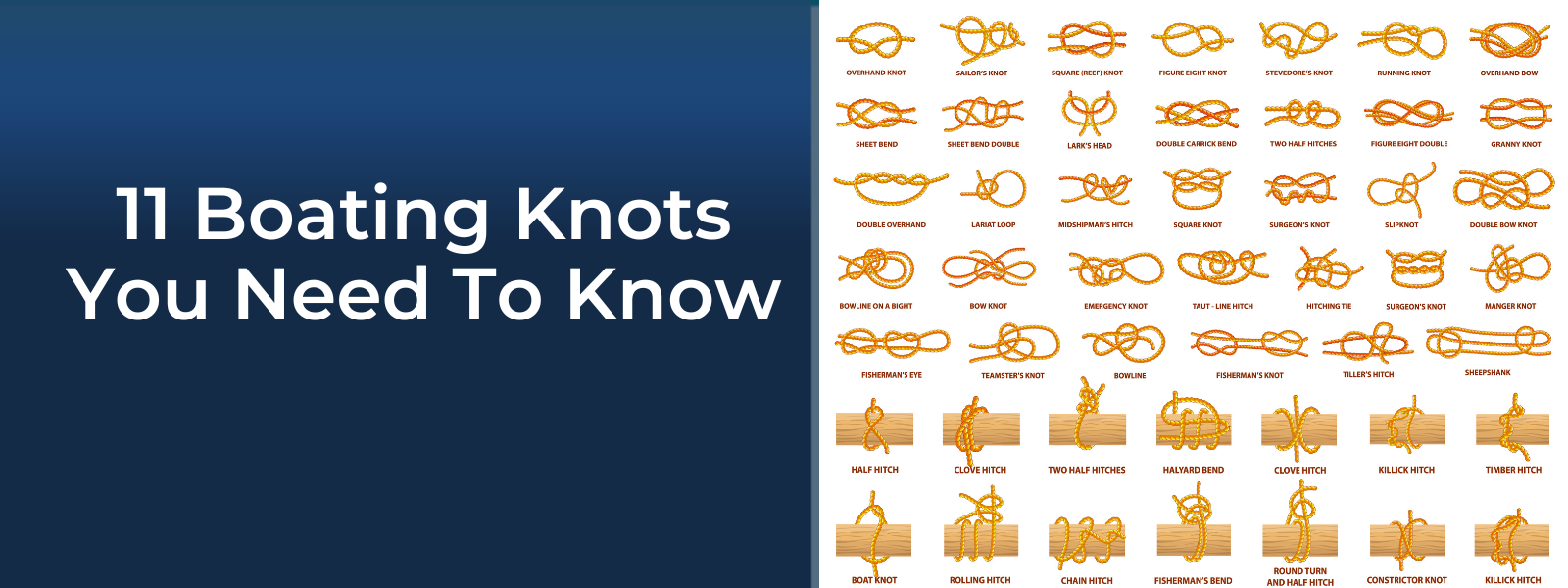

Table of Contents
Essential boating knots.
- Figure-Eight Knot
- Square Knot (Reef Knot)
- Double Half Hitch
- Rolling Hitch
- Clove Hitch
- Round Turn and Two Half Hitches
- Anchor Bend
Most Important Sailing Knots
Best boat knots to dock a boat:, basic boat knots every boater should know, common boating knot questions and answers.
Boating and sailing not only require skill and knowledge of navigation but also a mastery of various knots. These knots ensure safety, efficiency, and reliability. Whether you’re mooring, anchoring, or securing sails, the right knot can make all the difference. Here’s an expanded and detailed guide on essential boating knots, including their uses and step-by-step instructions.
Uses: The Half Hitch is often used in combination with other knots to add security. On its own, it’s a quick and simple way to temporarily secure a rope to a post, ring, or another rope. It’s not highly secure by itself but is a fundamental component of many more complex knots and hitches used in boating and sailing.
How to tie:
- Pass the end of the rope around the object (post, ring, etc.) to which you’re attaching it.
- Bring the end of the rope over and around the standing part.
- Pass the end through the loop you’ve just created.
- Pull tight to secure the hitch.
Note: For added security, multiple half hitches can be used in succession, and they are often combined with other knots to secure the rope more firmly.
Video link: How to Tie a Half Hitch
Uses: The bowline creates a secure loop at the end of a line, ideal for attaching to mooring posts, rings, or through items you’re securing. It’s vital for boating and sailing because it doesn’t slip or bind.
- Create a small loop in the standing part of the line, known as the ‘rabbit hole.’
- Tighten by pulling the standing part while holding the loop and tail.
- Pass the end of the line (the rabbit) up through the loop, around the standing part (the tree), and back down through the loop.
Video link: How to Tie a Bowline Knot
Uses: Essential for securing your boat to a dock or cleat. This knot is quick to tie and release, even under load.
Wrap the line around the base of the cleat, once completely.
- Make a figure-eight pattern around the arms of the cleat.
- On the final wrap, form an underhand loop and slip it over the arm of the cleat.
- Pull tight to secure.
Video link: How to Tie a Cleat Hitch
Uses: A stopper knot, preventing the end of a rope from fraying or slipping through a pulley or block.
Make a loop by twisting the rope on itself.
- Pass the end of the rope over the standing part, then back through the loop you created.
- Pull tight to form the figure-eight shape.
Video link: How to Tie a Figure-Eight Knot
Uses: Joining two ropes of equal thickness, ideal for securing reefing lines or tying off sail material. Not recommended for critical applications due to slippage with uneven loads.
- Take two rope ends, one in each hand.
- Tie a simple overhand knot by passing the right end over the left, then under it.
- Tie another overhand knot, this time passing the left end over the right, then under it.
- Pull both ends to tighten the knot.
Video link: How to Tie a Square Knot
Uses: Joining two ropes of different thicknesses. It’s especially useful in sailing for attaching sheets (lines that control the sails) to the sails themselves.
Make a bight (a U-shape) with the thicker or more slippery rope.
- Pass the end of the other rope through the bight from behind.
- Wrap the end around both parts of the bight, then back under itself.
Video link: How to Tie a Sheet Bend
Uses: Securing a rope to a pole or ring, useful in mooring and securing tarps or covers.
Pass the rope around the object.
- Bring the end over and around the standing part, then through the loop created (first half hitch).
- Repeat the process to create the second half hitch.
- Tighten both half hitches against the object.
Video link: How to Tie a Double Half Hitch
Uses: Attaching a rope to a pole, another rope, or to relieve tension on a jammed rope or pulley in sailing.
Wrap the rope around the object it’s to be attached to.
- Make a second wrap in the same direction, ensuring it lies next to the first.
- Make a third wrap, but this time cross over the first two wraps.
- Tuck the working end under the third wrap and pull tight
Video link: How to Tie a Rolling Hitch
Uses: Starting and securing lashings, tying a rope to posts, and temporary mooring. Not the most secure hitch, but quick to tie and untie.
Pass the rope around the post or object.
- Cross over the standing part to create a second wrap.
- Pass the end of the rope under the last wrap.
- Pull both ends to tighten.
Video link: How to Tie a Clove Hitch
Uses: Ideal for mooring and securing a boat to a dock or a buoy. Provides a secure attachment with the ability to adjust tension.
Wrap the rope around the object twice (round turn) for extra security.
- Tie a half hitch around the standing part of the rope, close to the object.
- Tie a second half hitch for added security.
- Tighten the knot by pulling on the standing part.
Video link: How to Tie a Round Turn and Two Half Hitches
Uses: Primarily for attaching a rope to an anchor. Known for its strength and security.
Wrap the rope around the anchor’s ring twice.
- Pass the end of the rope through the wraps in the direction opposite to the initial entry.
- Secure the end with two half hitches on the standing line.
- Tighten the knot and ensure it’s secure.
Video link: How to Tie an Anchor Bend
In sailing, knots serve critical roles in the handling and adjustment of sails, as well as in securing the vessel. Besides the universally useful Bowline and Cleat Hitch, sailors rely on several other specific knots which we have also covered in detail above:
- Bowline: Essential for creating a secure loop at the end of a halyard to attach sails.
- Cleat Hitch: Used to secure halyards and sheets to cleats on the deck.
- Figure-Eight Stopper Knot: Often tied at the end of lines to prevent them from running through pulleys.
- Single and Double Sheet Bend: Ideal for joining two lines of different sizes, commonly used to attach a jib sheet to the cleat.
- Rolling Hitch: Allows sailors to attach a line to a rod or another line under tension, useful for adjusting the tension on a line without releasing it.
Docking requires knots that can be both securely fastened and easily released, as conditions at the dock can change:
Cleat Hitch: The standard knot for tying a boat to a dock cleat, ensuring the boat stays put while allowing for quick release when needed.
Bowline: Used to create a loop that can be easily placed over a piling or a dock cleat.
Spring Line Hitch: A method of using lines at an angle to prevent the boat from moving forward or backward along the dock.
Fender Hitch: A quick and secure method to hang fenders on the side of the boat to protect the hull when docking.
Other Maritime Knots And Marine Knots Expanded
Beyond the basics, several knots have specialized uses in various maritime activities:
Carrick Bend: Used for joining two heavy lines, such as when towing or mooring.
- Stopper Knot: Essential for preventing a line from slipping through a block or a hole, with the Figure-Eight Knot being a common choice.
- Heaving Line Knot: A knot tied at the end of a light line to add weight, making it easier to throw.
For those new to boating or in need of a refresher, mastering the following knots will cover most scenarios you’ll encounter:
Bowline: The quintessential boating knot for creating a loop that won’t slip under load.
- Cleat Hitch: Essential for docking, allowing the boat to be securely tied but quickly released when necessary.
- Figure-Eight Knot: A basic stopper knot, preventing the end of a rope from running through retainers.
- Sheet Bend: Perfect for joining two ropes of different diameters, a common need in boating.
- Half Hitch: Used for securing a rope to a post, ring, or another rope, often used in combination with other knots for added security.
What is the most useful knot for a boat?
The Cleat Hitch is arguably the most useful knot for boating. It is versatile, easy to tie, and essential for docking, making it indispensable for boaters.
What is the strongest marine knot?
The Double Fisherman’s Knot (also known as the Grapevine Bend) is considered one of the strongest knots. It is primarily used for joining two lines of similar thickness and is known for its strength and stability.
What is a good knot to tie a boat to a dock?
The Cleat Hitch is the go-to knot for tying a boat to a dock. It is secure yet easy to untie, even after being under load. Its simplicity and effectiveness make it ideal for this purpose.
What are the 4 basic maritime knots?
- Bowline: A versatile loop knot that is secure and easy to untie.
- Cleat Hitch: Essential for docking, allowing for quick and secure fastening to a cleat.
- Figure-Eight Knot: A basic stopper knot, providing a quick method to prevent a rope from running out.
- Sheet Bend: Ideal for joining two ropes of different thicknesses, essential for many boating scenarios.
What are the 4 knots essential for sailing?
The 4 basic maritime knots listed above are 4 basic knots that are considered essential for sailing . They include:
- Cleat Hitch:
What are the 8 basic knots?
The 8 basic knots include the 4 basic maritime knots and 4 additional knots. Here is the full list:
- Reef Knot (Square Knot)
These knots form the foundation of maritime knot-tying, covering a wide range of boating, sailing, and general maritime activities. Mastery of these knots ensures readiness for most situations encountered on the water, enhancing safety, efficiency, and the overall maritime experience.
In conclusion, each knot serves a specific purpose, from securing your vessel to a dock, joining ropes of different sizes, to ensuring the safety of your sails and cargo. By familiarizing yourself with these knots, you equip yourself with the knowledge and skills to handle various situations at sea confidently. Practice tying these knots regularly to ensure you can tie them correctly and efficiently when the need arises.
Happy boating!

Related Posts

How does the effect of alcohol while boating compare to its effect while on land? Boating Test Study Guide

How Long Can You Finance a Boat? Average Boat Loan Term Ultimate Guide

What is the risk when a PWC passes too closely behind another boat? Boater Test Questions And Answers

What is a deck boat | Ultimate guide to the deck boat vs bowrider and other boats

5 Basic Boating Knots for Beginners
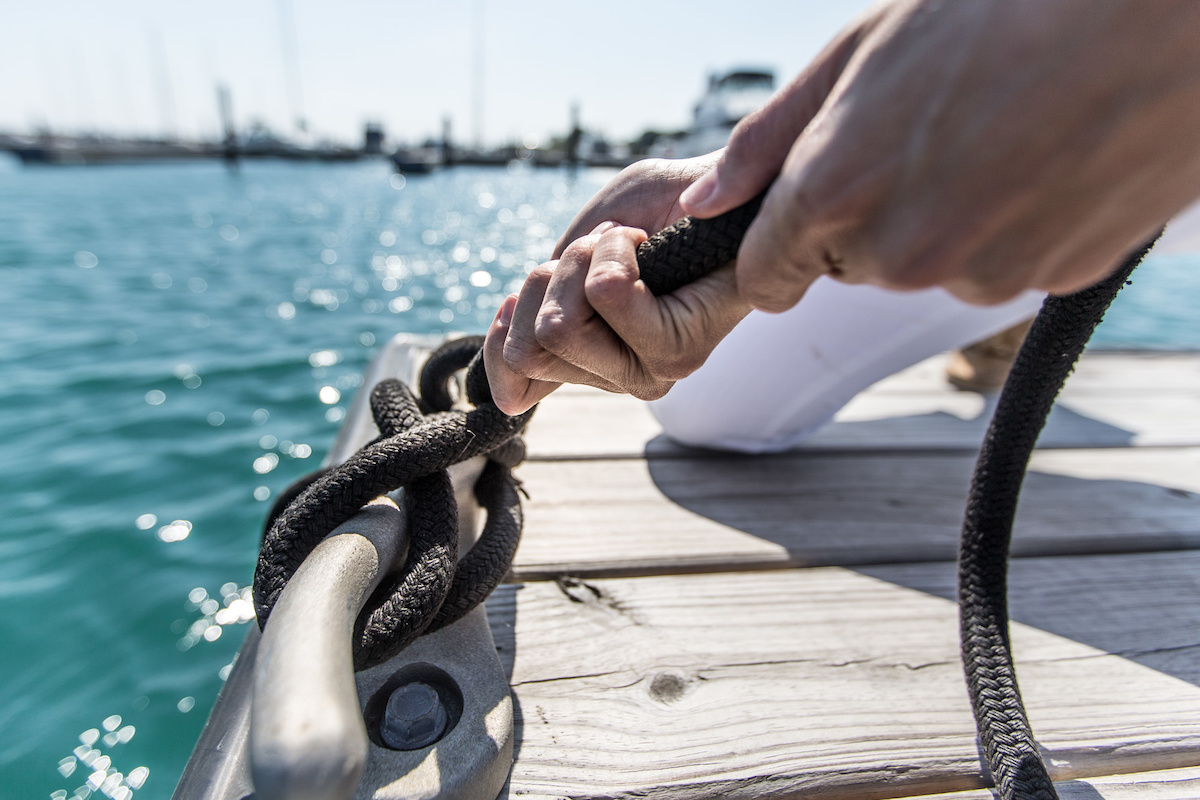
Every boat owner needs to know how to perform some important tasks, like docking a boat , tying up a boat , and anchoring a boat . All of these endeavors and many other common boating procedures share one thing in common: they involve handling lines. And just about any time line-handling is involved, knot tying may be, too. Here are the five most commonly used boating knots.
5 Basic Boating Knots:
- Cleat Hitch
- Clove Hitch
- Half-Hitch (also call the Overhand Knot)
- Figure Eight
Bowline Knot
The bowline is used to create a loop in the end of a line, which can come in handy for any number of reasons ranging from securing a line to a piling, to attaching two lines together. The big advantage it has over other knots one might use to put a loop in the end of a line is that it’s very easy to un-do, even after the line’s been under a large amount of tension.
- Step 1: Make a small loop in the line a couple feet from the end, then pass the end of the line up through the loop you just made.
- Step 2: Wrap the end around the main line above the loop, turn the end back down, and thread it back down through the loop.
- Step 3: Tug hard on the end and on the main line above the loop you’ve created, to snug the knot down.
Cleat Hitch Knot
Whether you’re pulling into the fuel dock or cleating off an anchor line, you need to know the cleat hitch. The good news? It’s amazingly simple.
- Step 1: Wrap the line around one side of the base of a cleat, under the “horns” (the ends on either side).
- Step 2: Pull the line across the top of the cleat, then loop it under the horn on the other side.
- Step 3: Reverse directions, and go across the top of the cleat going the other way.
- Step 4: To finish the cleat hitch, reverse direction again as though you were going to wrap under the opposite horn again. But instead of passing the line under it, form a small loop and flip it upside-down. Put the loop you just made over the horn, the pull hard so the line cinches down on itself. Then repeat the same process, on the second horn of the cleat.
Clove Hitch Knot
Clove hitch knots come in handy when you want to secure a line to a rail. Many boaters use them for tasks like hanging coils of line for neat stowage, or securing fenders so they hang down from a bowrail. You can actually tie the clove hitch in one of two different ways, depending on if you’re tying it around a rail, or if it’s a pole or post with an open end. First, let’s look at the rail method.
- Step 1: Wrap the line one time around the rail or pole.
- Step 2: Begin wrapping around the rail a second time, with the line crossing over top of the first wrap. Finish the second wrap, but before pulling it tight, pass the tag end back underneath. Then tug, to secure the clove hitch in place.
If you’re tying a clove hitch to a pole with an accessible end, you can cheat a bit and make it faster and easier with the same result.
- Step 1: Make a loop, and pass it over the end of the pole.
- Step 2: Make a second loop and flip it over so the tag end faces the first loop, then pull it tight.
One word of caution about the clove hitch: if the line isn’t under slight pressure all the time, or if it rotates on the rail or pole, it can come undone. So never use this knot for heavy-duty tasks like securing a boat to a dock. Some people even like to add a half hitch knot on top of a clove hitch, just to be safe.
Half Hitch (Overhand) Knot
Just about the simplest knot on the face of the planet, remember that half-hitches aren’t reliable all on their own. But they are a good way to secure then end of the line after tying a different knot, two half hitches together work just fine for securing a light-duty load, and they can be tied in a fraction of a second.
- Step 1: Pass the tag end of the line across the main line, pull it through the loop you just made, and give it a tug.
That’s it! You can tie a half hitch both in a line, and around a rail.
Figure Eight Knot
The figure eight knot is useful when you want to stop a line from passing through something, like a chock or a pulley (and is sometimes called a “stopper” knot for that reason). Be careful, though, because if both ends of the line are put under a lot of stress, you may have difficulty getting the figure eight back out of the line later on.
- Step 1: Make a loop in the line.
- Step 2: Wrap the tag end over the main line, and pass it back through the loop.
- Step 3: Pull both ends to cinch it tight, or push the knot to adjust its position and then cinch it tight.
Bonus Knot: Loop-to-Loop
Okay, a loop-to-loop is really more of a tactic than a knot. It’s used to join two lines with loops on their ends to one another, so as you know how to tie a bowline, you can always use the loop-to-loop to connect lines with one another. And, it’s uber-easy and fast. Just pass the tag end of a line through the loop of line number two, and then pass it through the loop in its other end. Then pull on the tag end until the two loops come together.
Read Next: How to Tie Up a Boat
You Might Also Like:
- How to Dock a Boat
- Anchoring a Boat: Step-by-Step Guide
- How to Tow a Boat
- Best Boats for Beginners
- The Ultimate Boat Buyer's Guide
Join Our Newsletter!
Get community news, buying bargains, and how-to guides at your fingertips.
Welcome To NetKnots.Com | The Most Trusted Knots On The Net.

Boating Knots
Rope Knots, sailing and boating go hand in hand. In fact most knots trace back to the early days of sail. For example, the Buntline Hitch was used to secure buntline to the foot of the sails on square-rigged ships. Mouse over a knot name in the list below to see a description of that knot.
Alpine Butterfly Knot
Anchor Bend

Ashley's Bend
Bowline On A Bight
Buntline Hitch
Carrick Bend
Cleat Hitch
Common Whipping
Double Bowline Knot
Flemish Bend
Halyard Hitch
Harness Bend
Heaving Line Knot
Icicle Hitch

Lanyard Knot
Marlinspike Hitch
Midshipman's Hitch
Monkey Fist
Mooring Hitch
Overhand Knot
Portuguese Bowline
Quickie Coil
Racking Bend
Rolling Hitch
Running Bowline
Sailor's Coil
Slipped Overhand Knot
Slipped Sheet Bend
Spanish Bowline
Stevedore Stopper Knot
Trucker’s Hitch
Tucked Sheet Bend
Z-Drag 3:1 System
Zeppelin Bend
Disclaimer: Any activity involving rope can be dangerous and may even be life threatening! Knot illustrations contained in this web site are not intended for rock climbing instruction. Many knots are not suitable for the risks involved in climbing. Where failure could cause property damage, injury, or death, seek professional instruction prior to use. Many factors affect knots including: the appropriateness of knots and rope materials used in particular applications, the age, size, and condition of ropes; and the accuracy with which these descriptions have been followed. No responsibility is accepted for incidents arising from the use of this content.
- ©2018-2020 netknots.
- All rights reserved
- Privacy Policy


- Find A School
- Certifications
- North U Sail Trim
- Inside Sailing with Peter Isler
- Docking Made Easy
- Study Quizzes
- Bite-sized Lessons
- Fun Quizzes
- Sailing Challenge

How to Tie 3 Important Sailing Knots
By: American Sailing Equipment
There are as many sailing knots as there are stars in the night sky — or so it seems. But the reality is that most sailors can get along with only knowing a few, as long as they’re the right ones. In this blog I’ll single out three very important sailing knots, explaining what they’re used for and how to tie them. Don’t forget, it’s necessary to practice these in order to get them down. Your fingers need the tactile learning experience in order to develop muscle memory that will allow you to tie them quickly when you need to!
Knowing these basic knots will make you more useful as a sailing companion. Next time you go out sailing with a friend, take a charter , or join a flotilla , you’ll feel more comfortable helping out around the boat when it’s time to put fenders out, tie up to the dock, or make a line fast.
So, read about the knots here, and practice with any old piece of rope you have handy. (A synthetic rope like the ones used on sailboats works best!) Then sign up for an ASA sailing course to get hands-on practice. 1. Bowline
The bowline is the king of sailing knots. It has been in use by sailors continuously for at least 500 years. Simply put, the bowline is way of turning the end of your line into a loop. Why is this useful? You can tie it around a post or other fixed object to make the line fast, or on smaller boats it is used fasten the halyard to the sail. It can also be used to tie two lines together. It has a number of practical uses as well, such as hanging a hammock. Under pressure the bowline tightens, so it won’t give way. However, note that it’s impossible to untie while bearing a load!
HOW TO TIE IT: Step 1: Form a loop near the end of the line. (How much of the line you leave will depend on how big you want the final knot to be.) Step 2: Run the end of the line back through that loop. Step 3: Next, run the line around the standing end and back through the small loop. Step 4: Now grasp the end and pull the knot tight. Step 5: You should have a large loop now! Congratulations, you’ve tied a bowline.
2. Clove Hitch A clove hitch is an extremely useful and quick knot. It has the advantage of being very quick to tie and untie, but it doesn’t hold nearly as well as the bowline. On sailboats, one of its most common uses is hanging the fenders over the side as you come in to dock.
HOW TO TIE IT: Step 1: Wrap the end of the line around the post (or whatever you’re attaching it to). Step 2: Cross the line over itself and wrap it around the post again. Step 3: Loosen the last wrap slightly and slip the end under, then pull it taut. This is a way of “locking” the knot. Step 4: Give it a few tugs to make sure it’s secure, and you’re done!

3. Cleat Hitch This type of knot is designed especially for one purpose, and I bet you can guess what that is. If you said, “Making the line fast to a cleat,” you were correct. As you might imagine, this is used all the time on a sailboat, whether you’re docking, towing a dinghy, or rigging a preventer. Knowing how to do it will make you a much handier sailing companion!
HOW TO TIE IT: Step 1: Make a wrap around the base of the cleat. Begin your wrap on the edge furthest away from where the line originates. Step 2: Make a figure 8 on the cleat. If the line is going to be under a lot of pressure, and the cleat is big enough, repeat this two or three times. Step 3: Add a hitch to the final turn to lock it. Do this by making a loop with the tail end underneath, hook it around the cleat, and pull taut. The tail end should be pointing away from the line’s origin.
Remember, practice makes perfect! Don’t be surprised or discouraged if these sailing knots don’t come out right the first few dozen times you do them. But enough practice, and they’ll become like second nature. Armed with just these few knots, you’ll make a great addition to any crew, including one of the charter groups on our flotillas to places like Scotland, Croatia, and Tahiti.
The Art of Sailing
- Understanding Points of Sail The direction of the wind dictates the direction a sailboat can sail. The Points of Sail describe the range of courses a sailboat can and cannot travel.
- Understanding the Sails The sail is the driving force of the boat. A sailboat is only as good as its sails when you consider that capturing the wind’s energy is the premise behind what sailors do to propel their boats in a forward direction.
- Understanding the Wind A sailor’s world revolves around the wind and staying aware of the wind’s direction is crucial. Your ability to accurately sense changes in the wind, its speed and its direction will improve as you learn.
Related Posts:

- Learn To Sail
- Mobile Apps
- Online Courses
- Upcoming Courses
- Sailor Resources
- ASA Log Book
- Bite Sized Lessons
- Knots Made Easy
- Catamaran Challenge
- Sailing Vacations
- Sailing Cruises
- Charter Resources
- International Proficiency Certificate
- Find A Charter
- All Articles
- Sailing Tips
- Sailing Terms
- Destinations
- Environmental
- Initiatives
- Instructor Resources
- Become An Instructor
- Become An ASA School
- Member / Instructor Login
- Affiliate Login
- Understanding Knots: The Basics
Knot tying is an ancient skill that remains vital in various activities today, from sailing and boating to camping and climbing. Understanding how to tie a knot properly can make a significant difference in the safety and success of your endeavors. This guide will navigate you through the world of knots, highlighting the importance, types, and practical applications of knot tying.
At its core, a knot is a method for fastening or securing a rope or line by intertwining or looping itself. Knots have been used for centuries for countless purposes, including fishing, construction, and decoration. Knowing the right knot to use in a specific situation can be both a lifesaver and a time-saver.
Types of Knots
There's a vast array of knots, each with its unique purpose and application. Here are some of the fundamental categories:
Loop Knots : Create a loop in the rope that can take a load. Examples include the Bowline and the Figure Eight Loop.
Bend Knots : Join two ropes together. The Sheet Bend and the Double Fisherman’s Knot are popular options.
Hitch Knots : Attach a rope to another object like a post, ring, or another rope. The Clove Hitch and the Two Half Hitches are widely used.
Stopper Knots : Prevent a rope from slipping through a retaining device. The Figure Eight Knot is a classic stopper.
Sailing and Boating Knots
In sailing and boating, knot tying is not just a skill—it's an essential part of the craft. Knots such as the Bowline, Cleat Hitch, and Reef Knot are fundamental for securing sails, anchoring, and mooring boats. Understanding these knots can enhance safety and efficiency on the water.
Read more articles about sailing, sailing tips and destinations in our Magazine .
Knot Tying Techniques
Learning to tie knots requires patience and practice. Here are some general tips for mastering knot tying:
Start with the Basics : Begin with simple knots like the Square Knot and the Bowline. These form the foundation for more complex knot tying.
Use the Right Rope : The material and thickness of your rope can affect the knot's security. Start with a smooth, flexible rope for practice.
Practice Regularly : The more you practice, the more instinctive knot tying will become.
How Fast is a Knot?
When talking about "knot" in the context of speed, it refers to nautical miles per hour. Understanding this measurement is crucial in navigation and maritime activities. One knot equals approximately 1.15 land miles per hour.
The Importance of Knot Tying in Everyday Life
While knots are essential for sailing and boating, their utility extends into everyday life. From securing loads on a vehicle to tying a tie, knots play a pivotal role in our daily tasks. Learning different types of knots can prepare you for a variety of situations, whether you're at home, in the wilderness, or on the water.
Knot tying is a timeless and invaluable skill that enhances safety, efficiency, and effectiveness in various activities. Whether you're a sailor navigating the high seas, a camper setting up a tent, or simply someone looking to tie a secure knot for everyday tasks, understanding the art of knot tying is essential. With practice and patience, anyone can master this ancient craft and appreciate the intricate beauty and practicality of knots.
So what are you waiting for? Take a look at our range of charter boats and head to some of our favourite sailing destinations .

I will be happy to help you with your boat selection, please contact me.

Denisa Nguyenová

Sailing Knots
These knots could prove to be some of your best sailing companions. They need ample practice so that you can tie them perfectly and quickly when you need them. Your rope handling skills would come handy whenever you need to tie knots for mooring, anchoring, securing cargo, managing sails, preparing for a storm, towing another vessel, decorative purposes, etc. It helps if you take note of the pros and cons of the popular sailing knots. You should use ropes that can be used repeatedly and can be untied easily. The emphasis here is on reliability, safety and convenience.
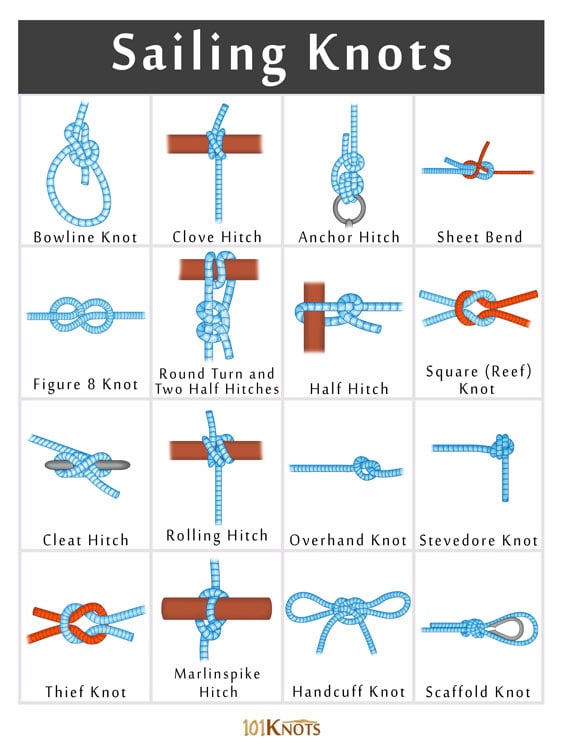
Essential Knots to Know for Sailing
- Bowline knot
- Figure 8 knot
- Square (reef) knot
- Clove hitch
- Round turn and two half hitches
- Cleat hitch
- Rolling hitch
- Anchor hitch
- Overhand knot
Other Different Sailing (Nautical) Rope Knots
- Stevedore knot
- Scaffold knot
- Diamond (lanyard) knot
- Buntline hitch
- French bowline
- Highwayman’s hitch
- Monkey’s fist
- Barrel hitch
- Marlinspike hitch
- Carrick mat
- Handcuff knot
- Sheepshank knot
- Timber hitch
- Two half hitches
- Double sheet bend

Timber Hitch The timber hitch is used to secure a rope round a post or any cylindrical...
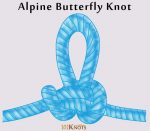
A useful midline knot, the butterfly knot has its uses in glacier travel and rock...
Carrick Bend The Carrick bend is a powerful knot to join two heavy ropes, hawsers...
Dropper Loop The dropper loop, also known as a dropper knot forms a secure structure...
- Privacy Policy
- Terms and Conditions
© 2024 ( 101Knots )
Complete Knot List
Use filters to narrow results, or search for a specific knot..
Note that searches for alternate names are accepted (e.g. “reef knot” for “square knot”).
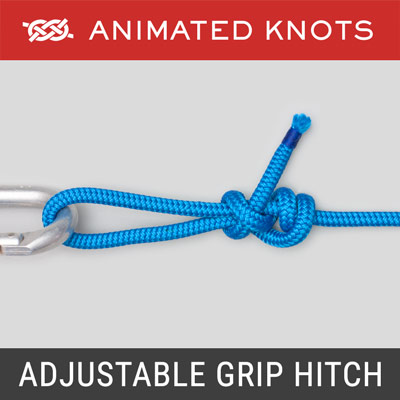
Used to tension a rope, e.g., a tent ridge line or a guy line.
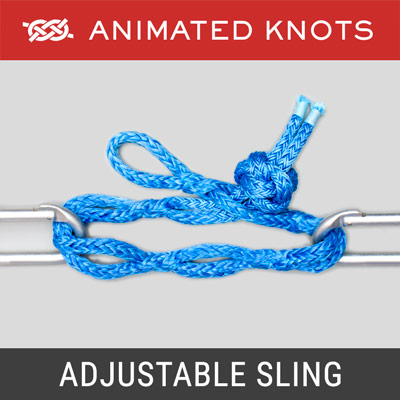
Adjustable Sling: push end through appropriate loop.
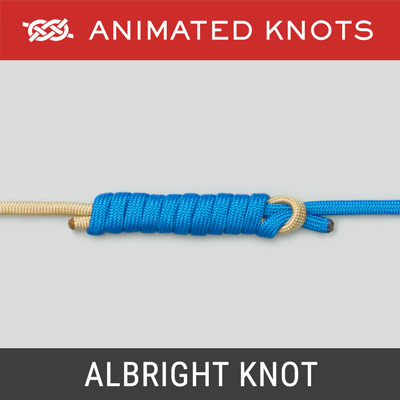
Join different types or thickness of fishing line.
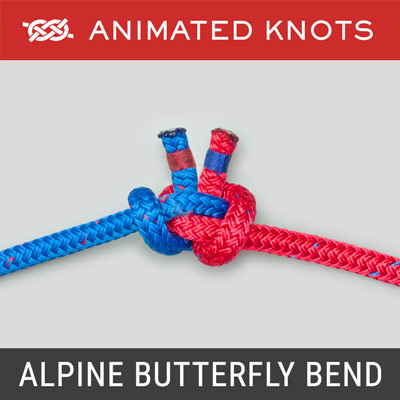
Reliable bend used to join two ropes of roughly similar size.
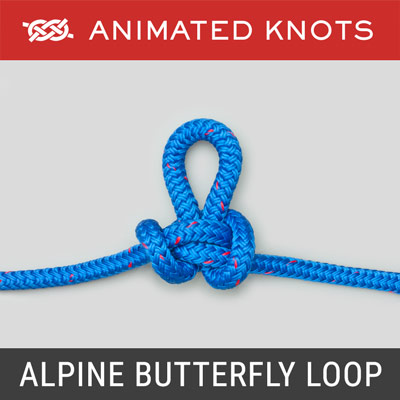
Secure loop in the middle of a length of rope.
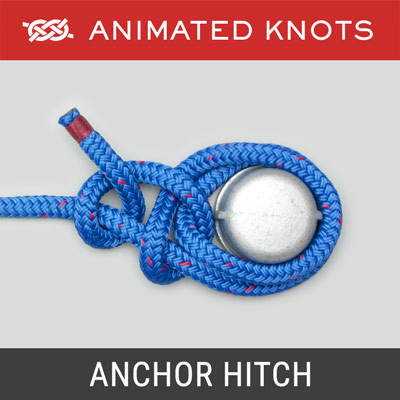
Excellent knot to attach an anchor line to an anchor.
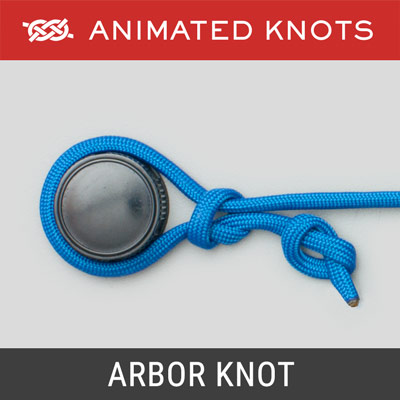
Used to attach the fishing line to the arbor or spool center.
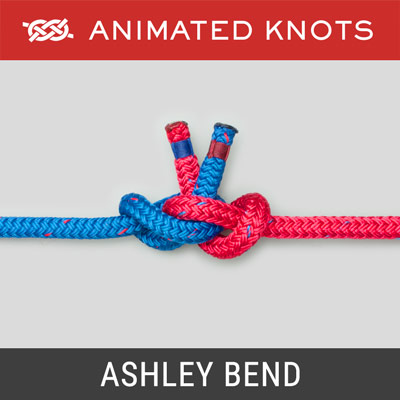
Joins two ropes using interlocking overhand knots.
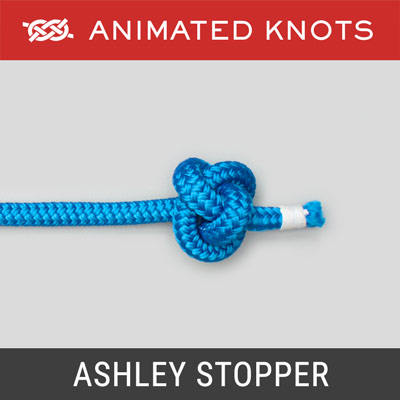
Makes reliable bulky stopper knot in the end of a rope.
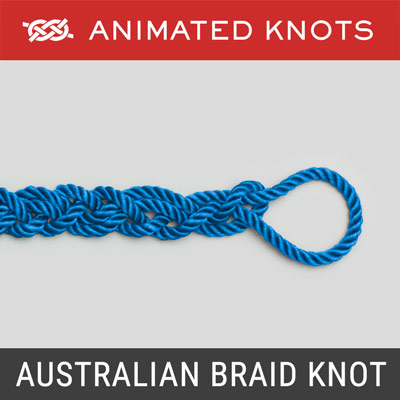
Strong loop for double-line leader and loop-to-loop join.
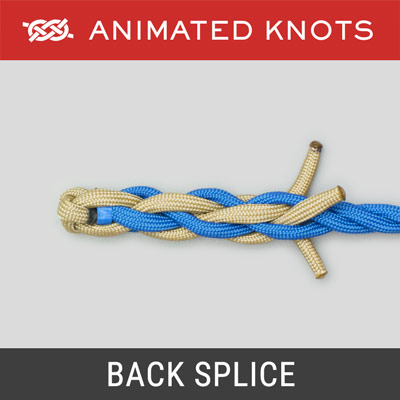
Secures end of twisted rope: Crown knot & tuck the ends.
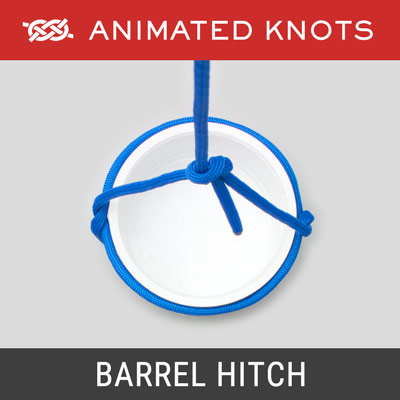
Secure method to lift barrels, buckets and other containers.
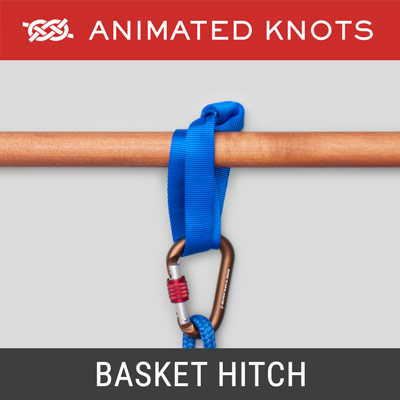
A webbing loop thrown over a branch provides an anchor.
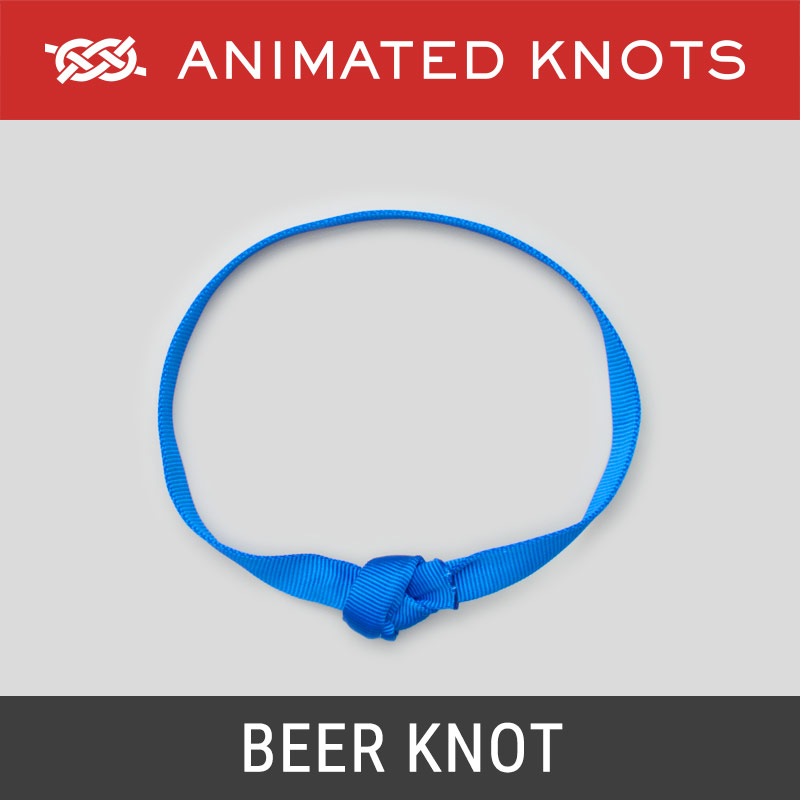
Joins ends of tubular webbing - finished with overhand knot.
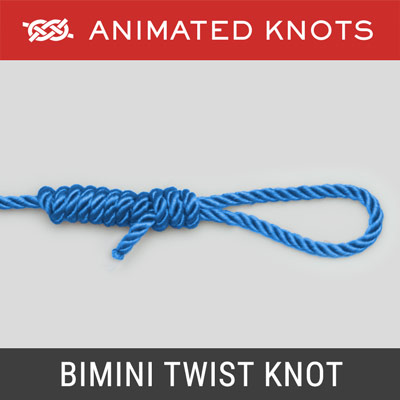
Strong double-line leader and for loop-to-loop connections.
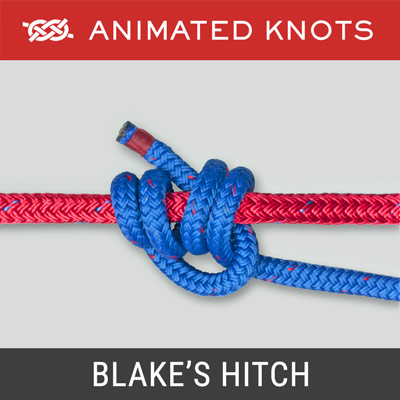
Slide and grip knot used for ascent and descent.
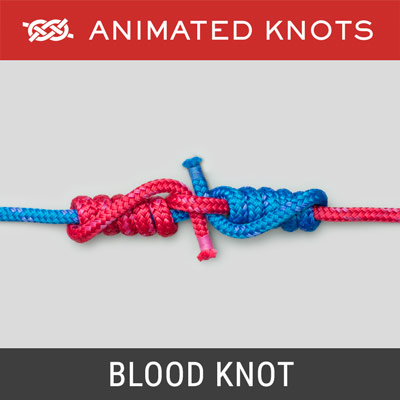
One of the best knots for joining two lines of similar size.
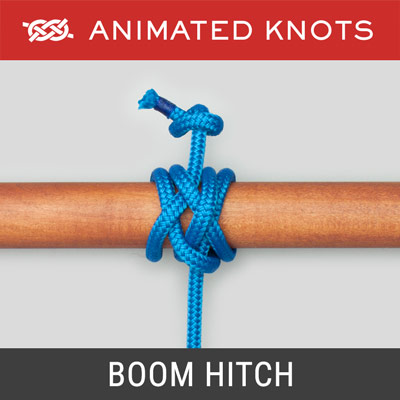
Attach rope to spar for right-angle strain or parallel strain.
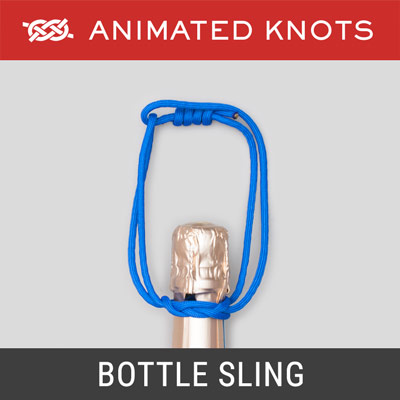
Creates carrying handle for a bottle that has a narrow neck

Provides the wearer with formality and elegance.
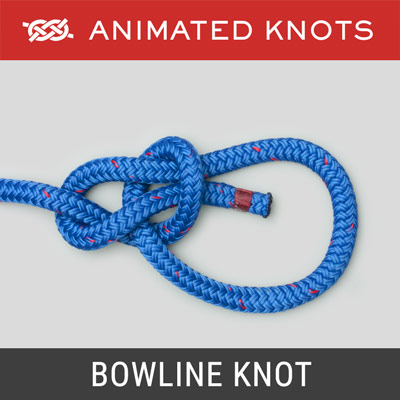
Reasonably secure loop in a rope's end - and easy to undo.
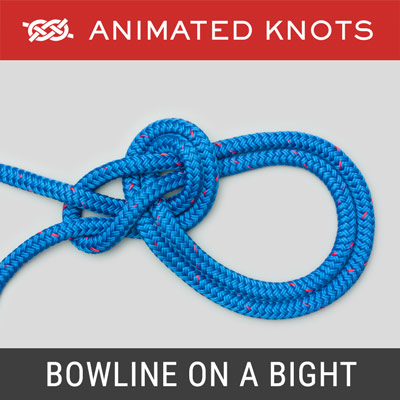
Bowline relative, but a double loop in the middle of a rope.
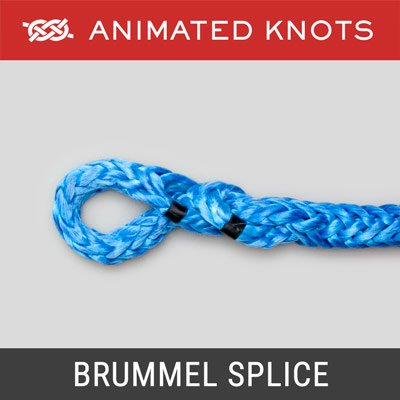
Create a secure, locked eye splice in a hollow braid rope.

Demonstration of the Brummel Eye Splice Structure
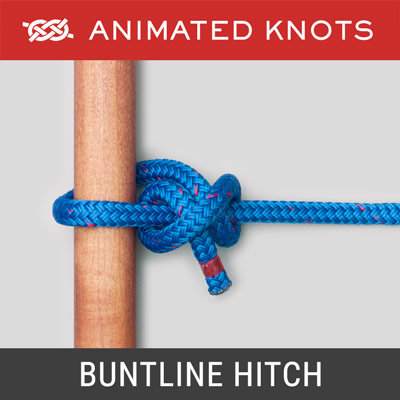
Secure hitch originally used to join buntlines to square sails.
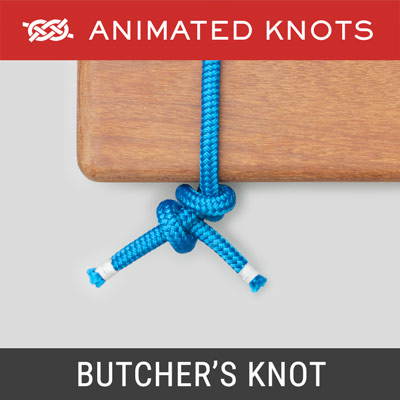
Rapidly tied knot to prepare meat for roasting or salting.
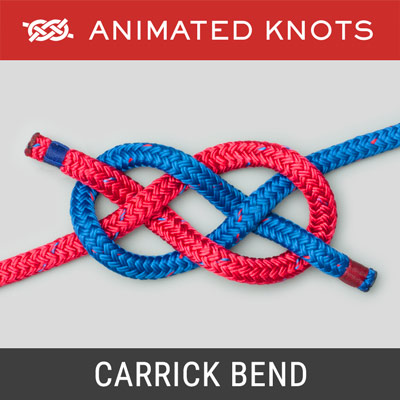
Secure rope join, readily untied even after a heavy load.
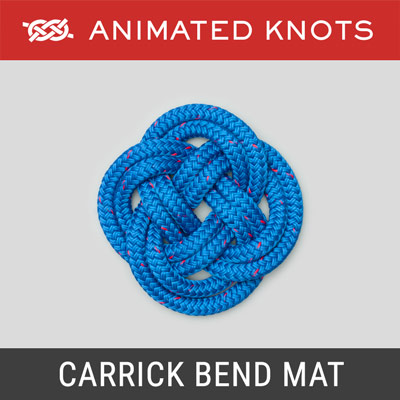
Provides the basic design for a small circular mat
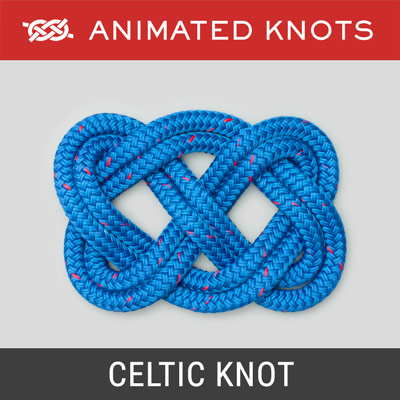
Makes a pleasing rope mat with a rectangular shape.
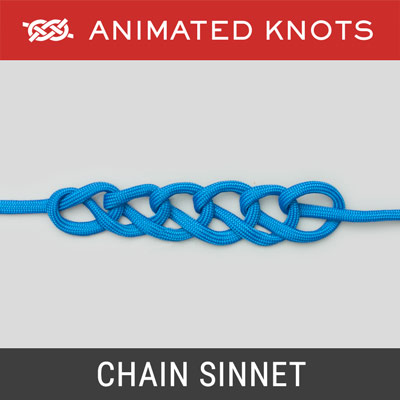
Decorative chain — shortens line and and prevents tangling.
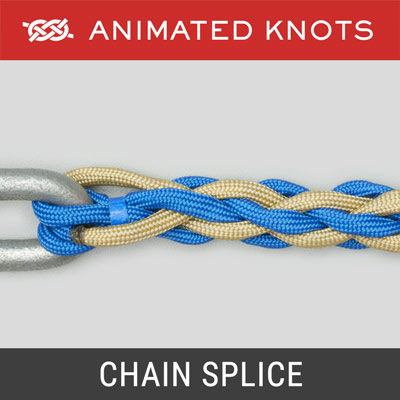
Securely attaches three-strand rope to anchor chain
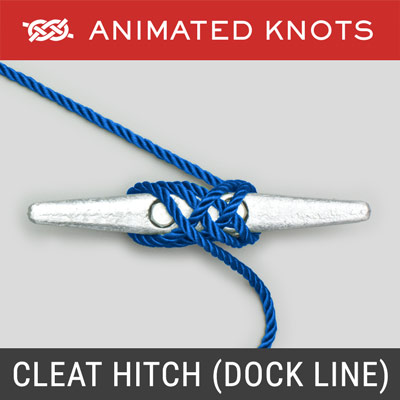
Attaches rope to cleat. Often used for Dock Lines.
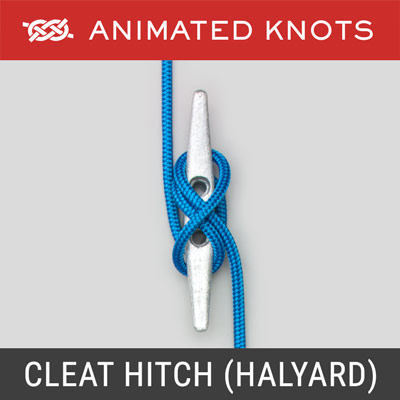
Attaches rope to cleat - used for halyards, clotheslines, etc.
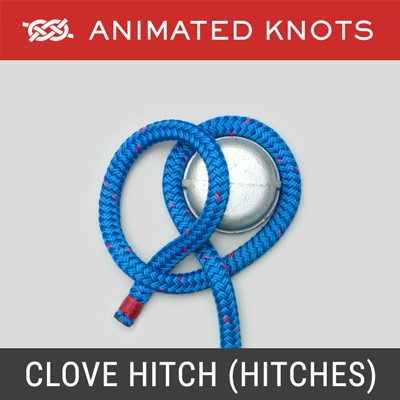
Simple (weak) hitch to attach a rope to a pole or ring
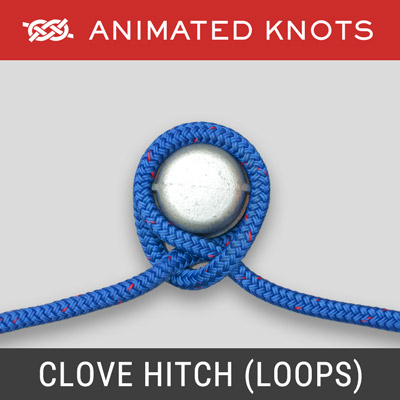
Temporary hold, e.g., stage scenery or mooring buoy
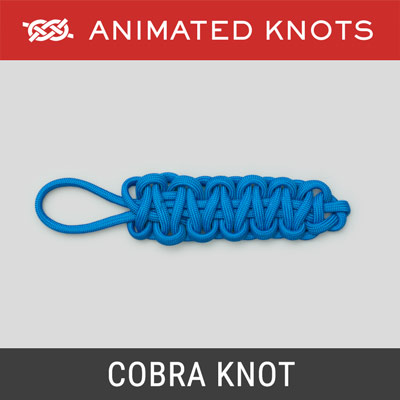
Neat knot for lanyards, e.g., military shoulder lanyards.
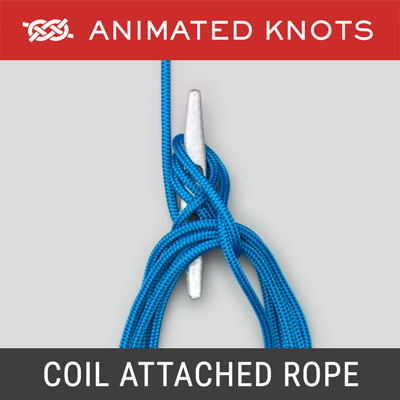
Method of coiling rope when one end is attached.
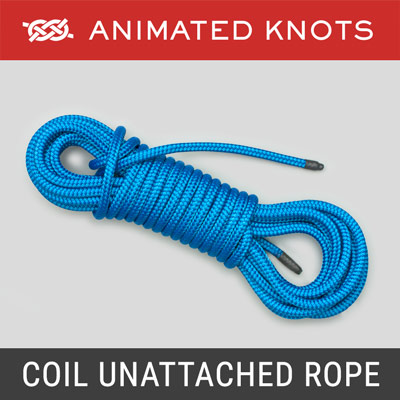
Secure and neat rope storage, minimizes tangles and twists.
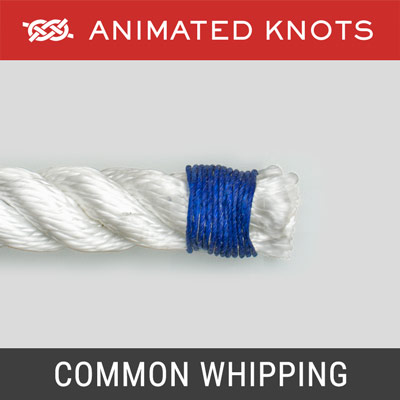
Classic, simple whipping, can be tied without a needle.
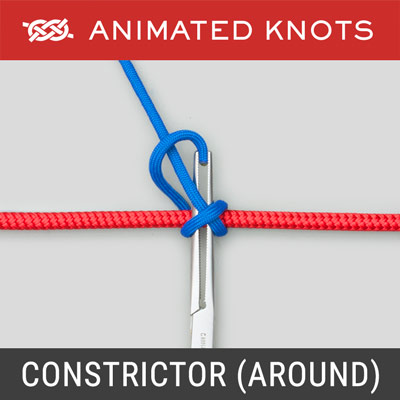
Surgical ligature used to secure duct or blood vessel.
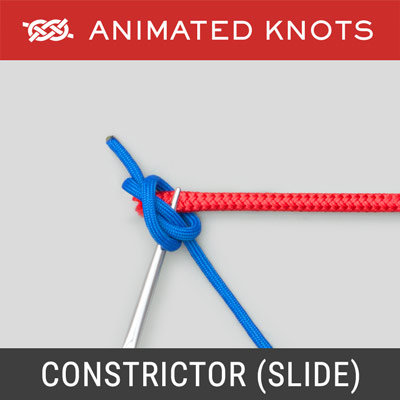
Surgical ligature tied at the end of duct or blood vessel.
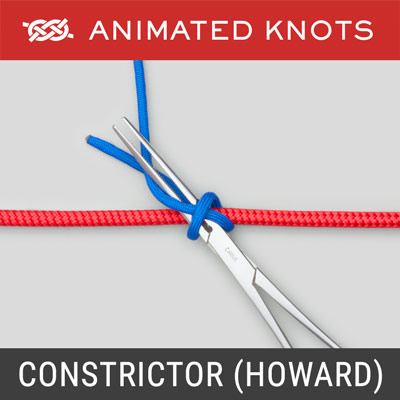
Surgical constrictor using the Howard technique.
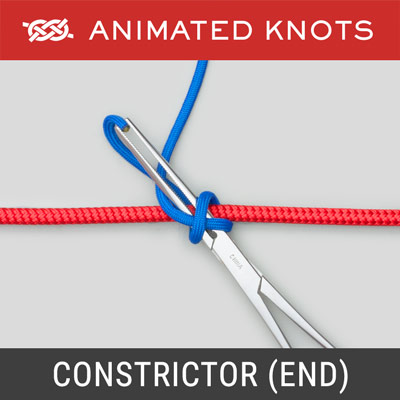
Surgical Constrictor using clamp to retrieve suture end.
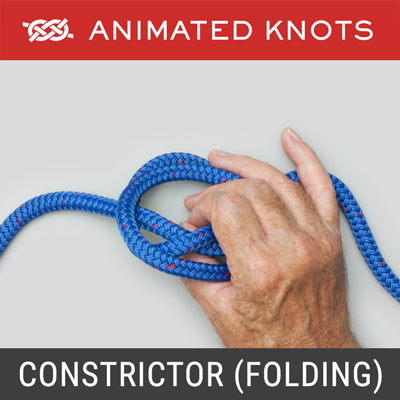
Tie the Constrictor knot using the folding method.
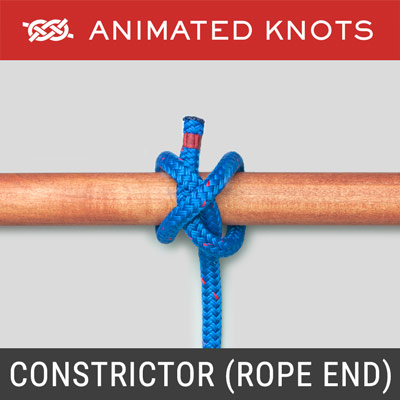
Tie the Constrictor knot using the rope end method.
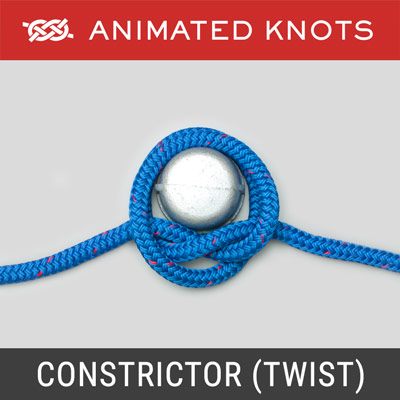
Tie the Constrictor knot using the twisting method.
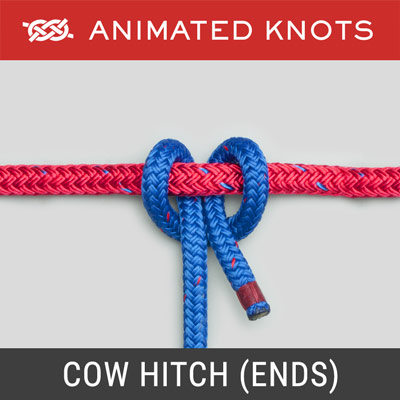
Temporary hitch for a light load or animal.
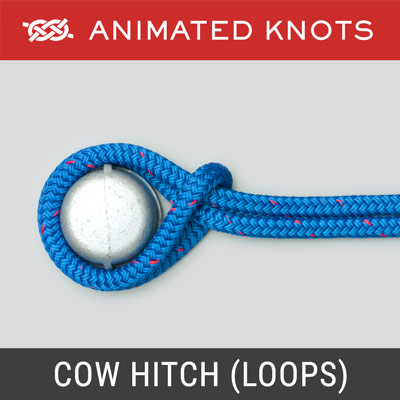
Starts a Back Splice; part of several decorative knots.
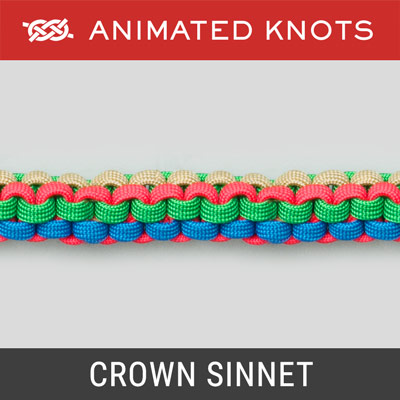
Decorative lanyard made using a series of Crown knots.
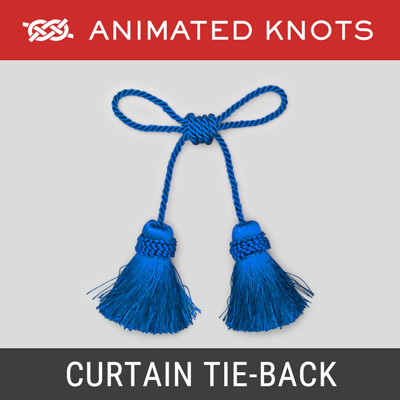
An elegant way to bunch curtain material together.
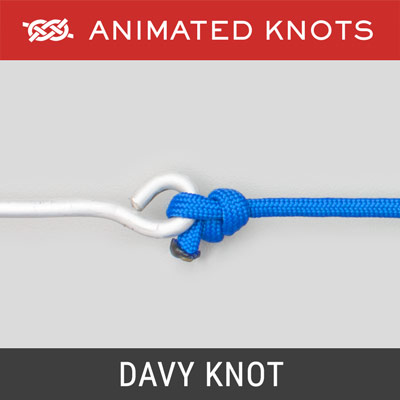
Easy and fast tying knot for attaching a hook or fly.
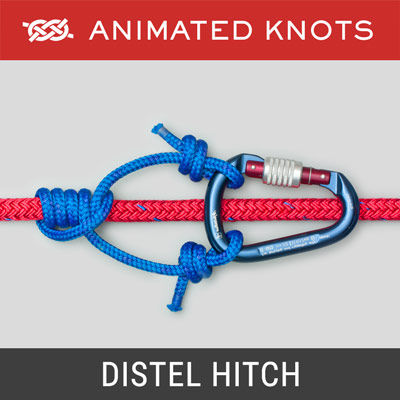
Slide and Grip knot: takes strain in only one direction.
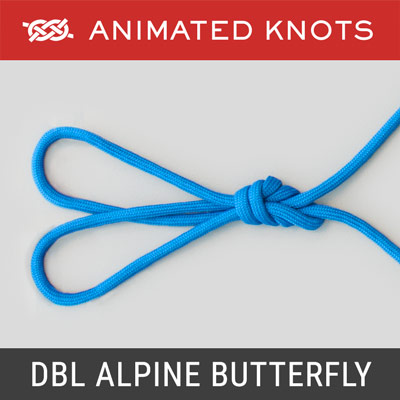
Creates two secure loops in the middle of a piece of rope.
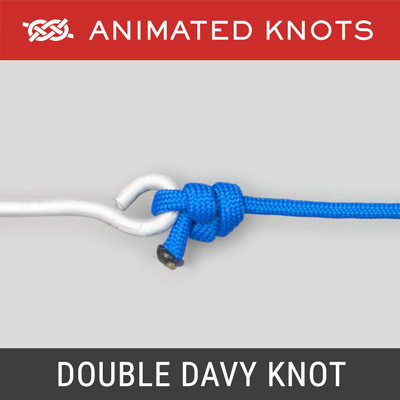
Secure, and fast tying knot for attaching a hook or fly.
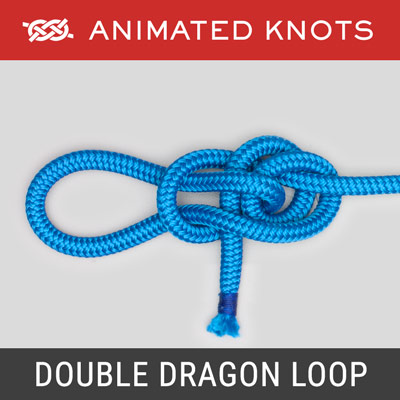
Creates an easy to remember end-of-rope loop
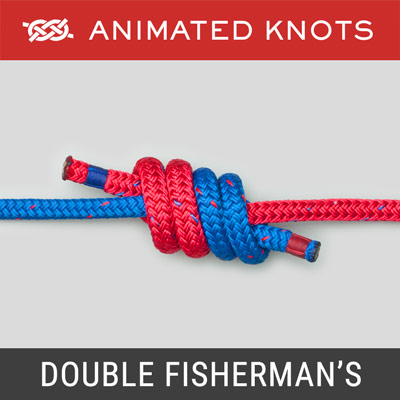
Securely joins two ropes of similar size.
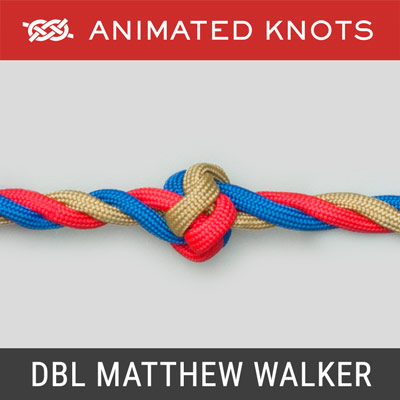
A secure stopper knot which cannot be untied.
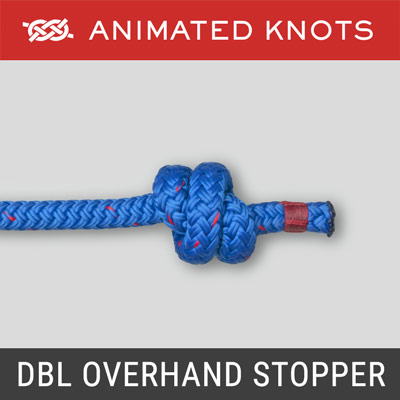
Makes a reliable, moderately large, stopper knot.
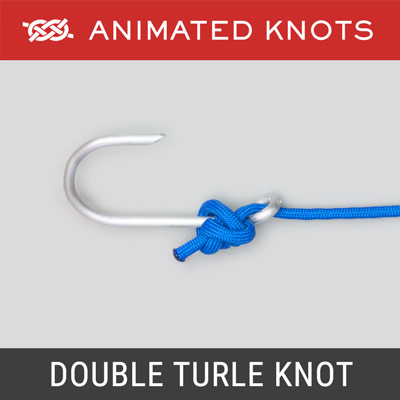
Simple knot used to tie a hook or fly to a leader.
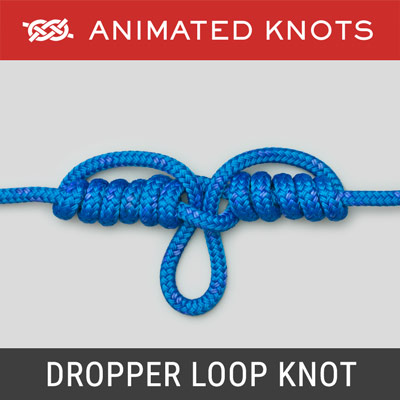
Creates a large loop in the middle of a line.
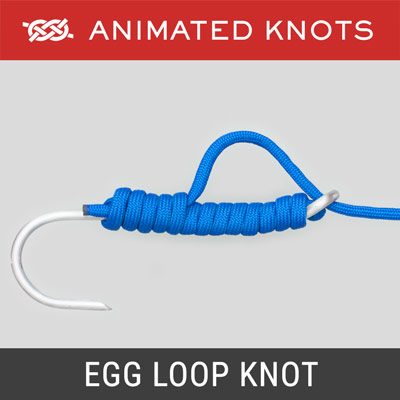
Attaches hook to leader and provides a hold for bait.
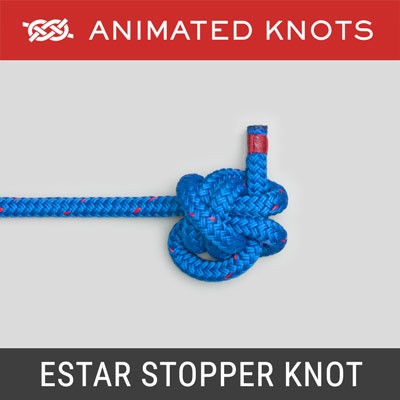
Stopper knot suitable for slippery rope like Dyneema
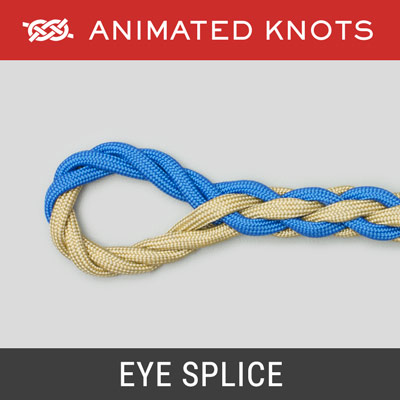
Secure loop in the end of 3 or 4-strand rope.
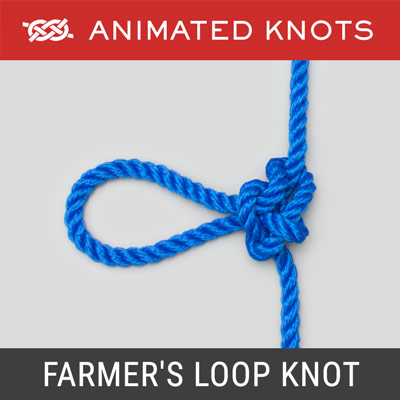
Makes secure loop in the middle of a piece of rope.
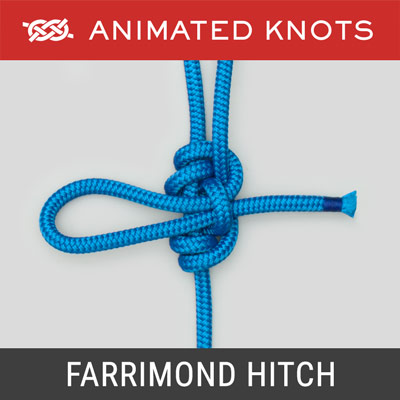
Quick method of rigging an adjustable tent ridge line.
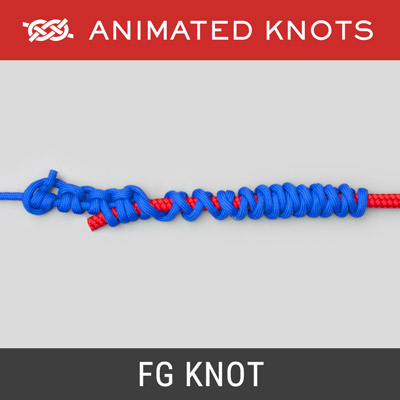
Securely joins braided line to leader
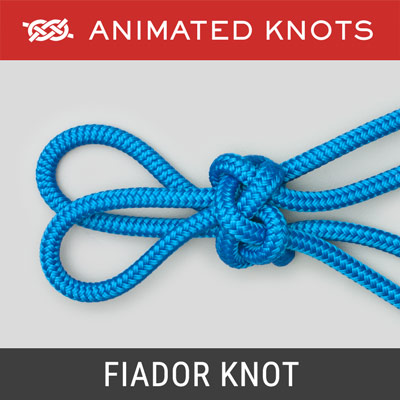
Component of rope halter or hackamore (horse headgear).
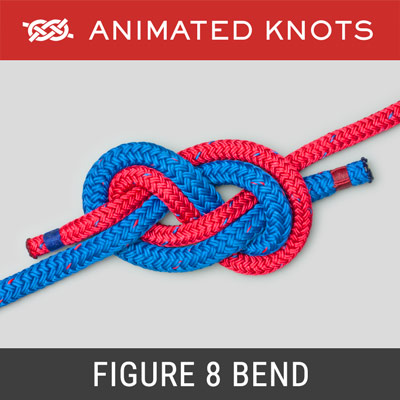
Secure, simple method for joining two ropes.

Mid rope loop to take strain in one direction only.
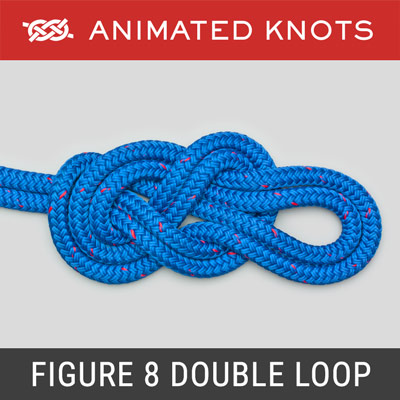
Stable double loop in the middle of a piece of rope.
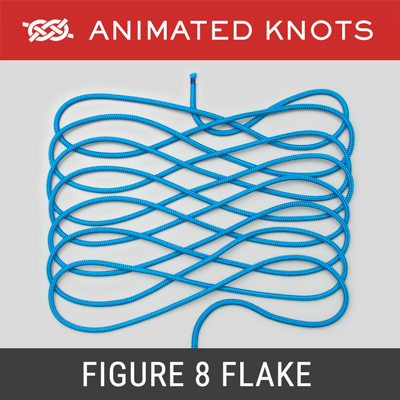
Arranges a rope neatly for fast and safe use.
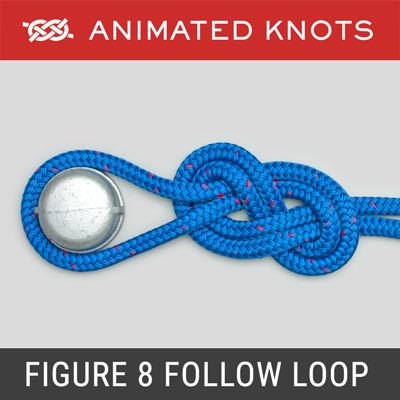
Links to closed ring using rethreading technique
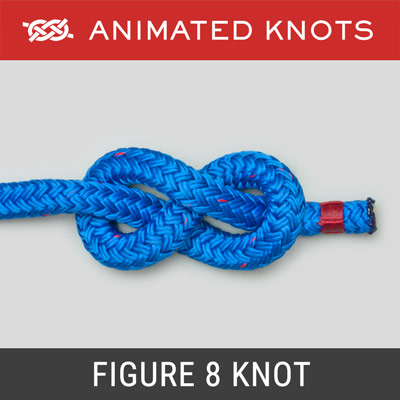
Non-binding, quick and convenient stopper knot.
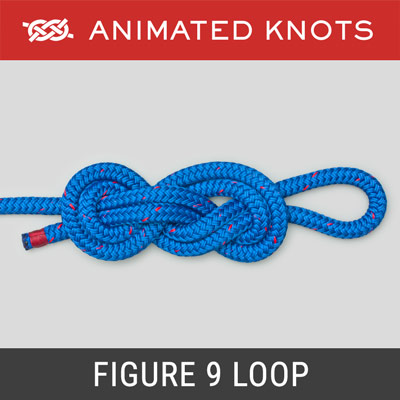
Makes a secure loop using a rope bight
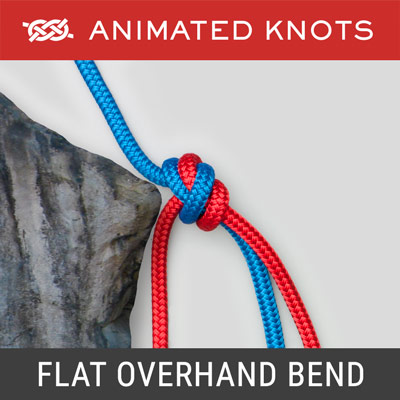
Joins two climbing ropes with one simple Overhand knot
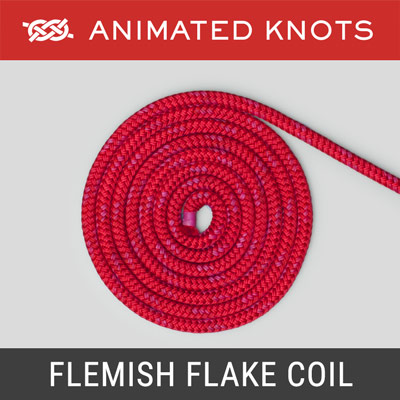
A neat and attractive way to temporarily stow a rope's end.
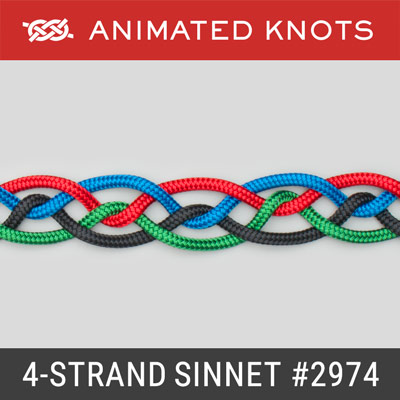
Creates a flat four-stranded decorative braid.
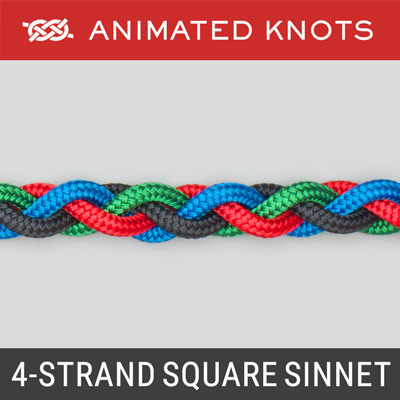
A decorative solid braid that can also be used for hair.
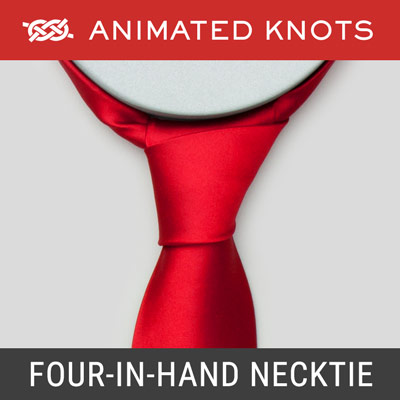
Quick, convenient, but slightly asymmetrical, necktie.
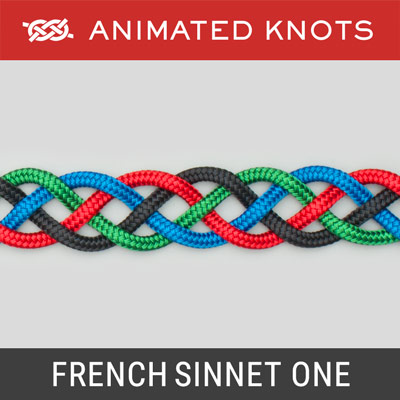
A neat symmetrical braid useful for decoration.
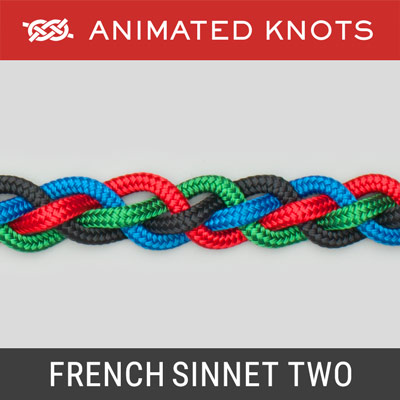
Uses a webbing loop sling to attach item to harness.
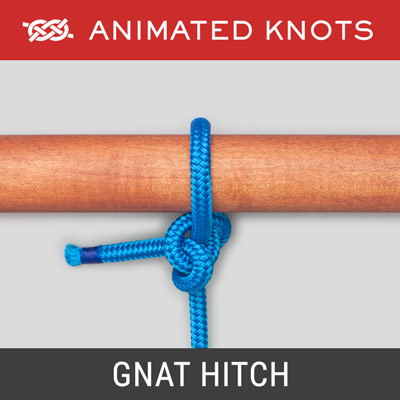
Makes a very useful, small, secure hitch knot
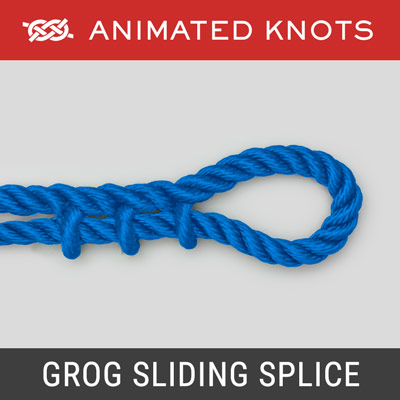
Makes an adjustable splice for multi-strand rope.
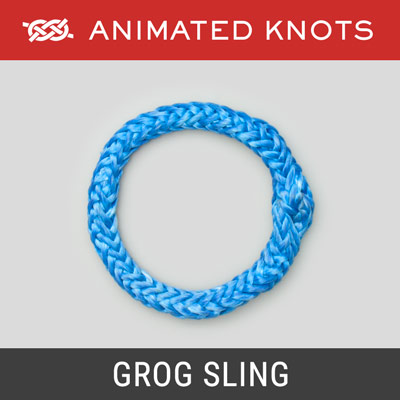
Creates a rope loop using hollow-braid rope.
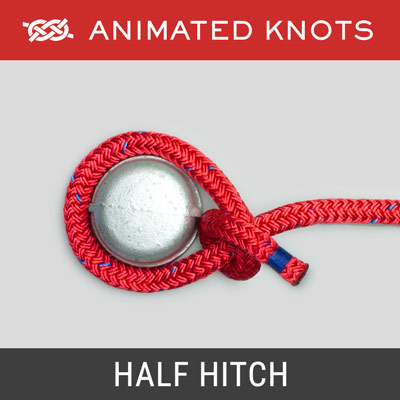
Used to tie rope around an object and back to itself.
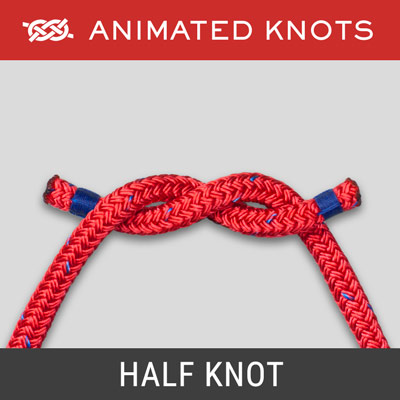
Simple binding knot: first step of the Square (Reef) Knot.
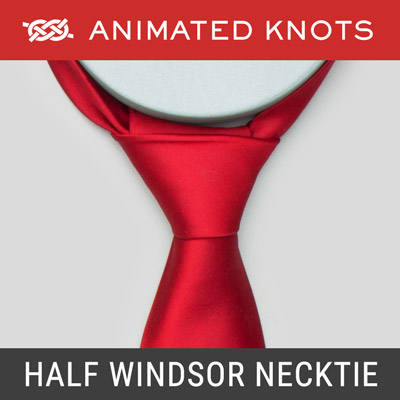
Creates a symmetrical and moderately bulky knot.
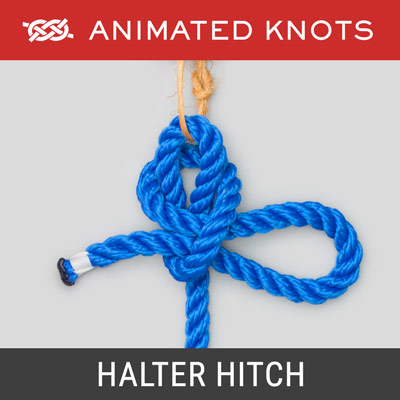
Quick-release knot commonly used to secure a horse
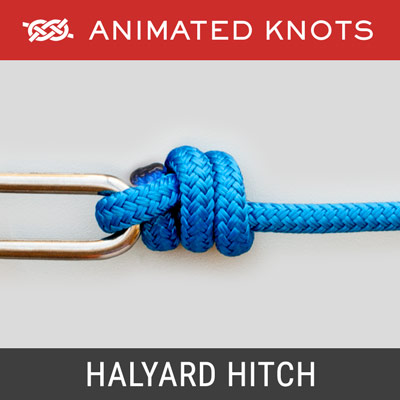
Compact knot to join halyard to a shackle at top of a sail.
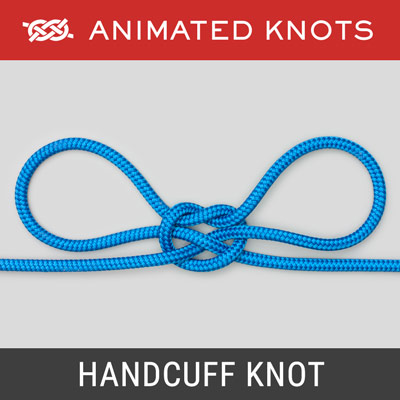
Can be used as a rescue chair or animal restraint
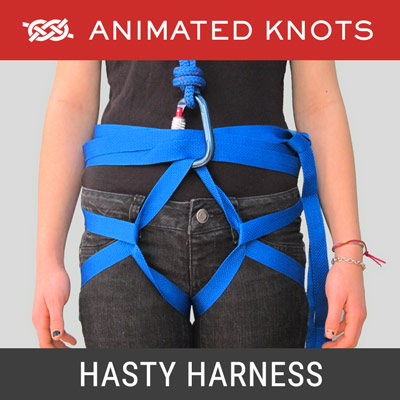
Seat for emergency use made from webbing strap.
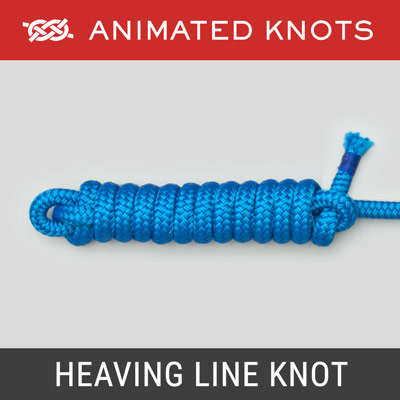
Weights end of a rope to make it carry further when thrown.
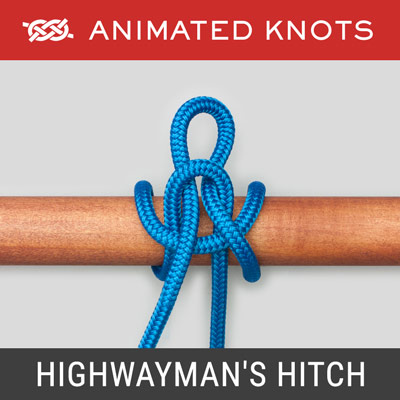
Quick-release knot supposedly used by highwaymen.
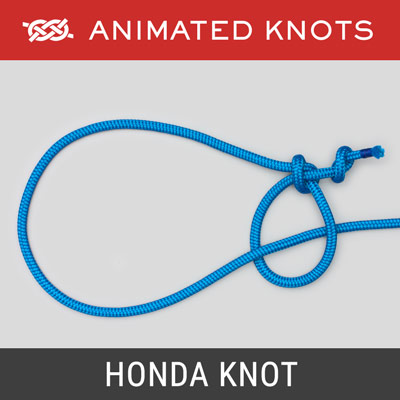
The essential component of a Lariat used as a Lasso.
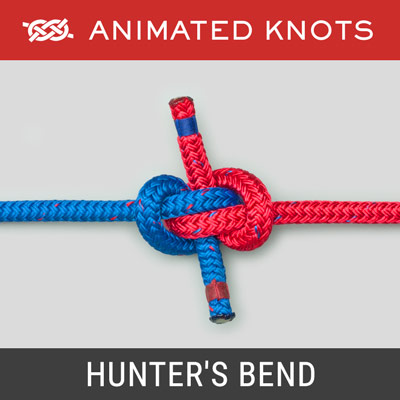
Joins two ropes together of roughly the same size.
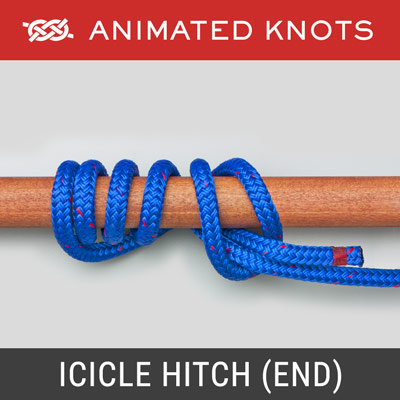
Very secure slide and grip knot that may grip on tapered pole.
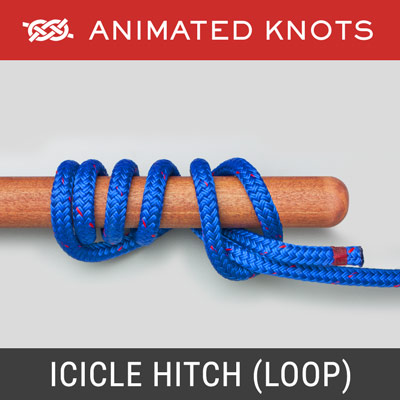
Attaches a fishing line to a hook, lure, or swivel.
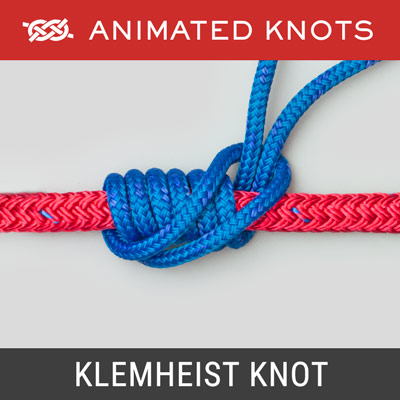
Slide and Grip knot that takes strain in only one direction.
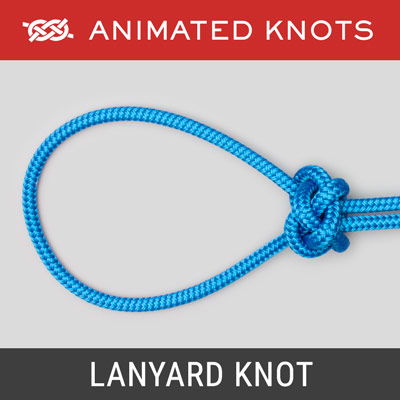
Often used as a decorative component of a Knife Lanyard.
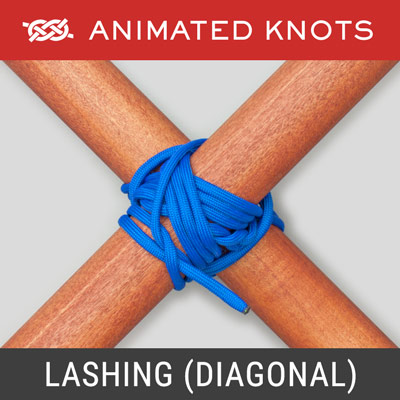
Secures diagonal braces to hold a structure rigid.
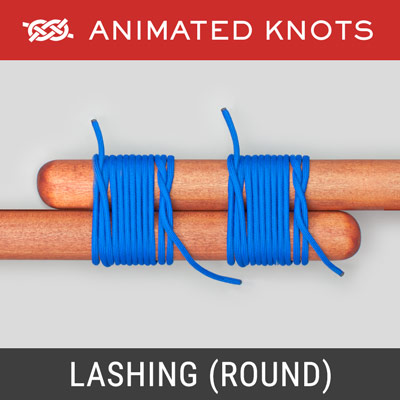
Securely binds two poles together to make an end join.
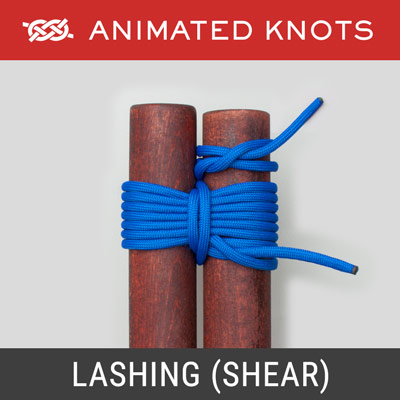
Joins two poles with other ends apart as shear legs.
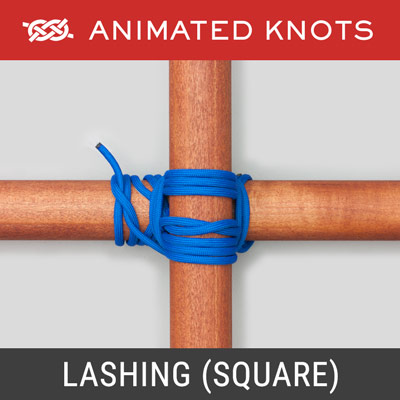
Binds two poles together at a 90-degree angle.
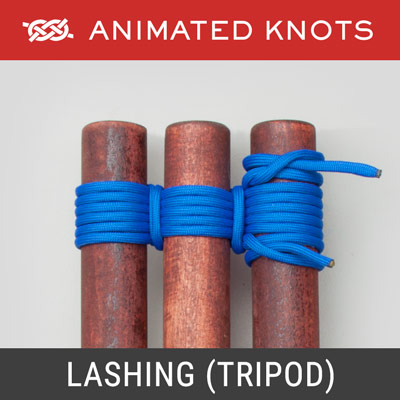
Joins three poles to one another for use as a tripod.
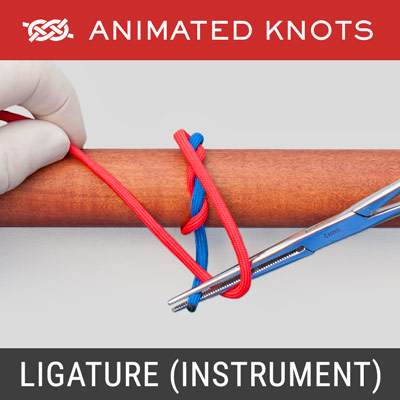
Surgical Double-Throw knot tied using an instrument
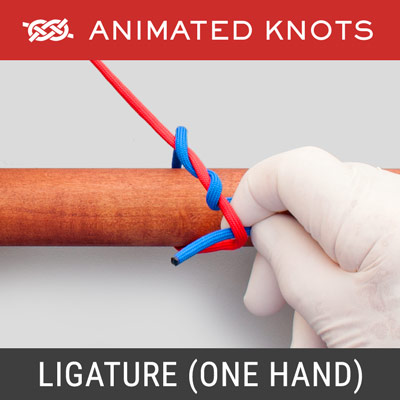
Surgical Double-Throw knot tied using one hand.
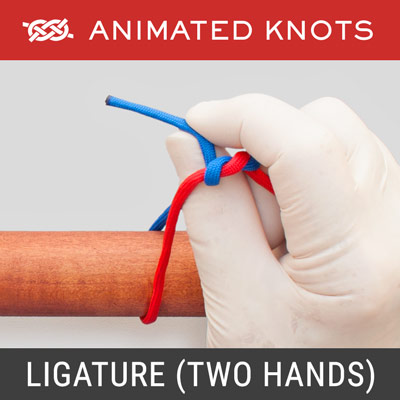
Surgical Double-Throw knot tied using two hands.
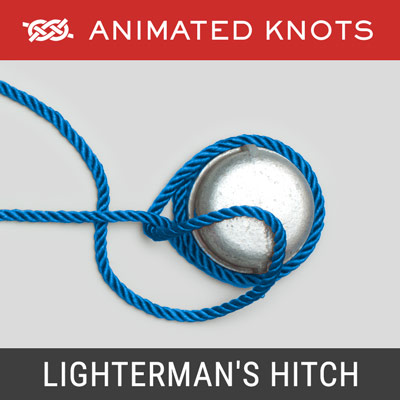
Simple strong way to secure a tow line to a bollard
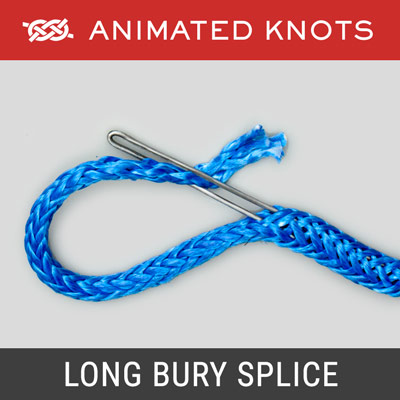
Hollow Braid Eye Splice with end threaded up rope center.
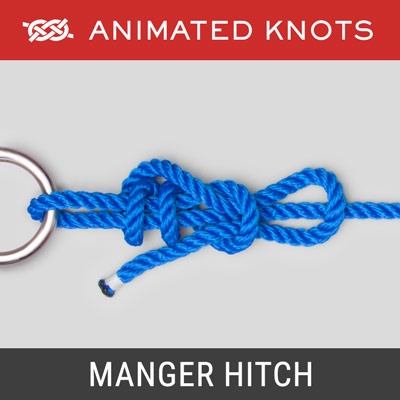
Excellent quick-release knot to secure a cow to a fence.
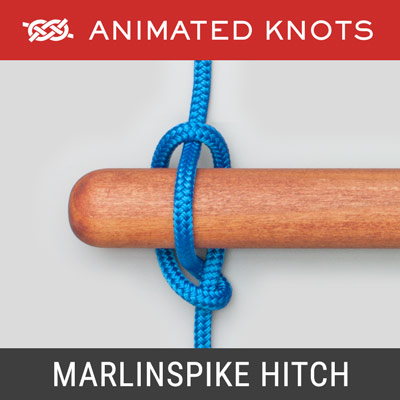
A stick or spike is used to make a knot in the rope .
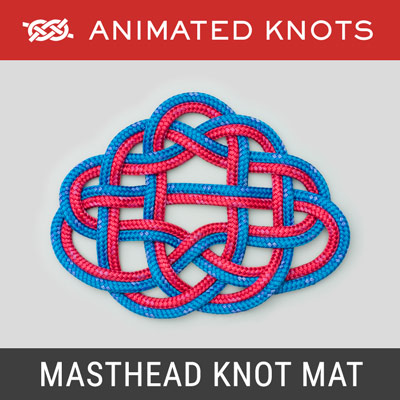
Pleasing, quickly-made mat based on the Masthead Knot
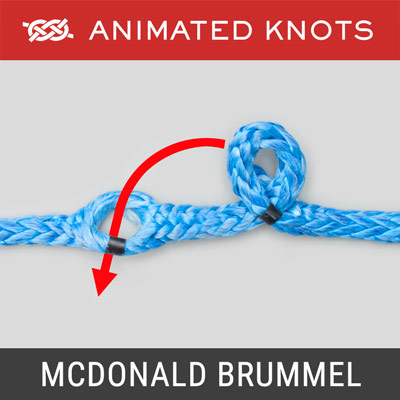
McDonald's quick Brummel splice for hollow braid rope.
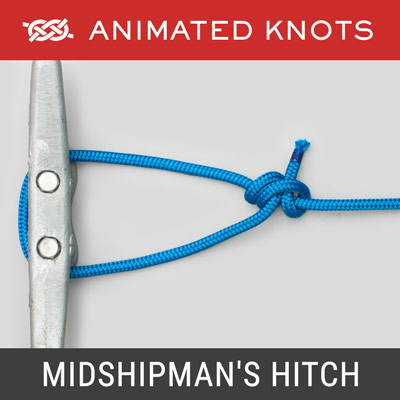
An adjustable loop tied using a Rolling Hitch
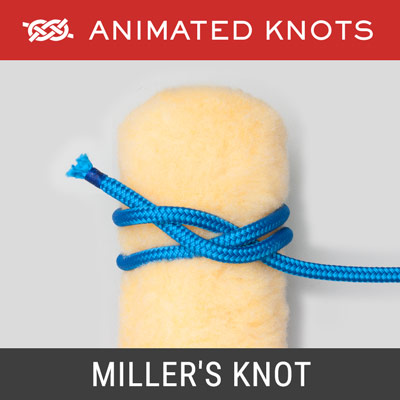
Secures neck of a sack or bundle of items.
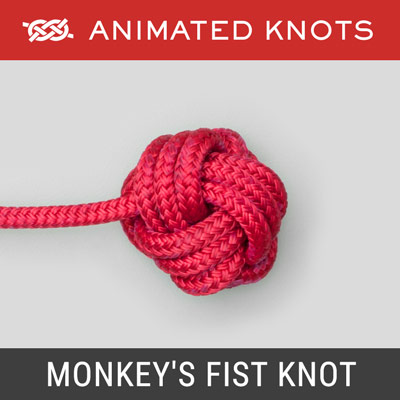
Makes neat ball on a rope's end when throwing it.
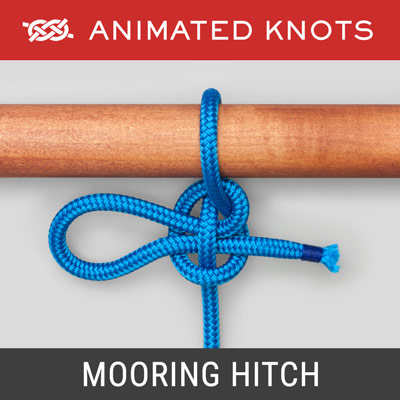
Quick-release knot to hold a boat temporarily to a dock.
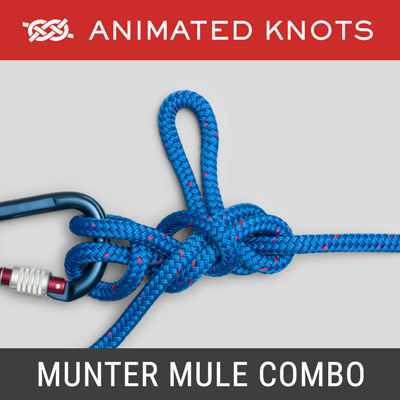
Slide and Grip Knot to control rappelling (abseiling).
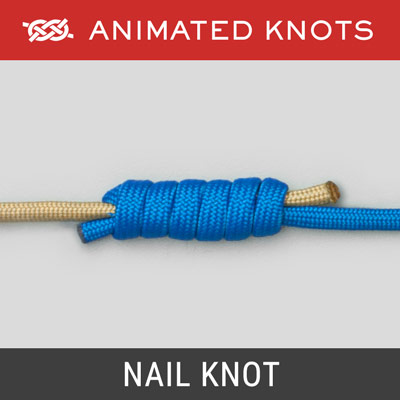
Used to join two lines of different diameters.
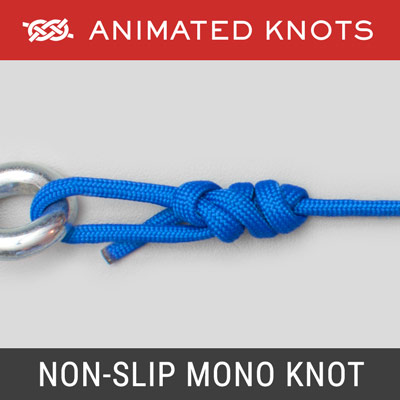
Creates a very strong fixed loop in the end of a line.
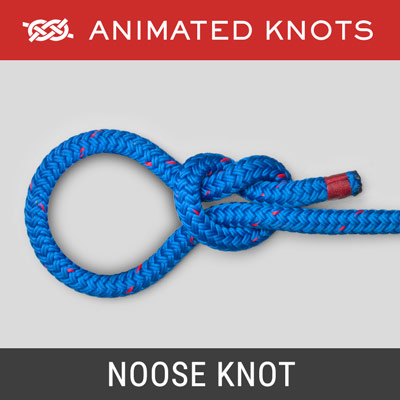
Creates a loop that tightens when pulled.
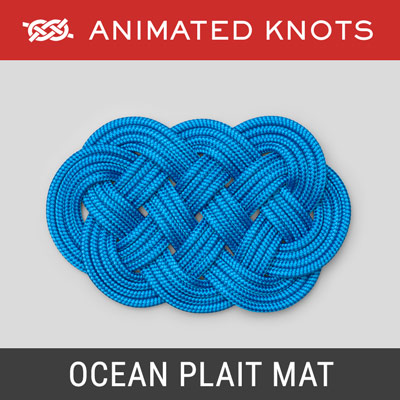
Makes a mat based on many crossings of Overhand Knots.
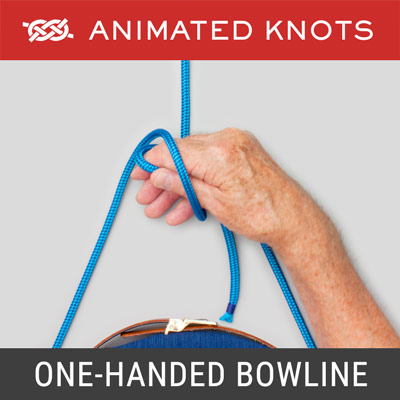
Allows the Bowline to be tied using one hand.
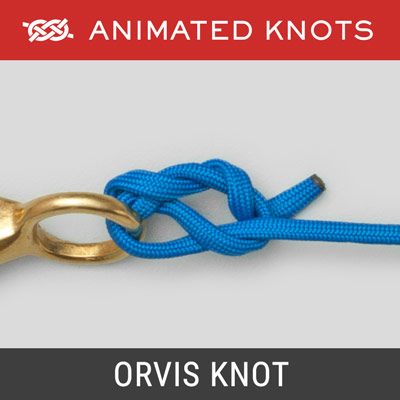
Strong, small, light & reliable knot to attach a hook to a line.
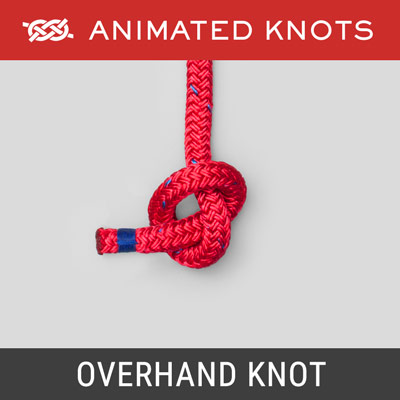
The simplest of the Single-Strand Stopper Knots

Knots to use to tie a package securely.
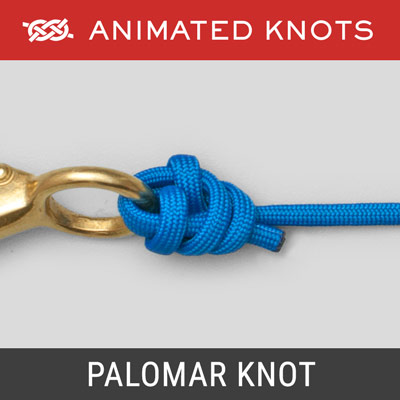
Simple knot to attach a line to a hook, or a fly to a tippet.
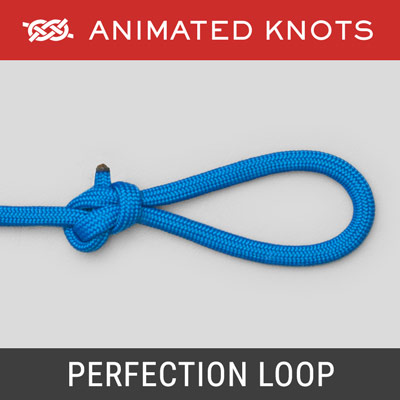
Small loop in end of a leader aligns with the standing end.
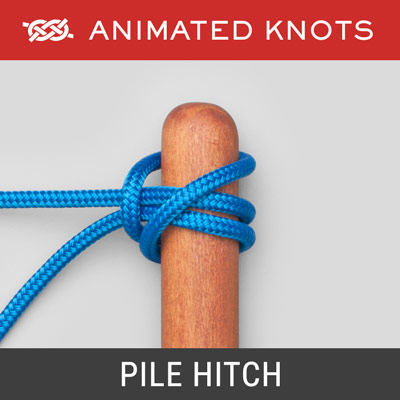
Easy attachment to a mooring pole or to make rope fence.
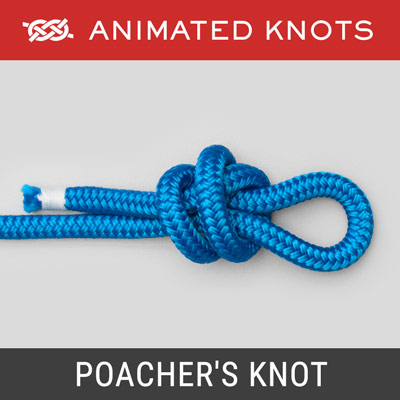
Makes a very secure loop in the end of a piece of rope

Produces a moderately large and symmetrical knot.
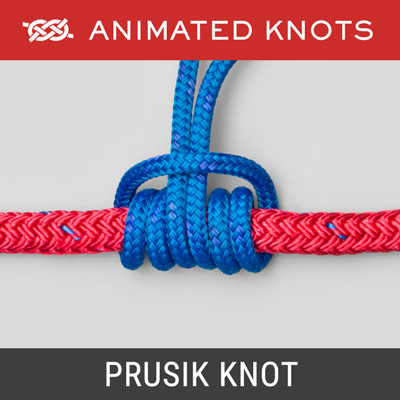
Symmetrical 3-turn slide and grip (friction) knot.
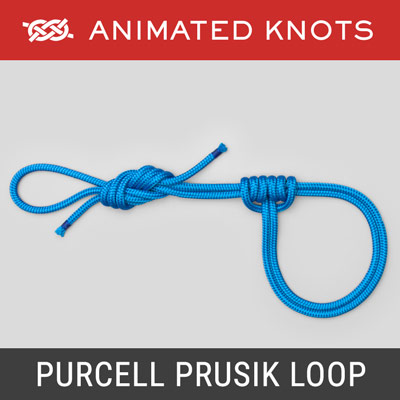
Adjustable sling system based on Prusik loops.
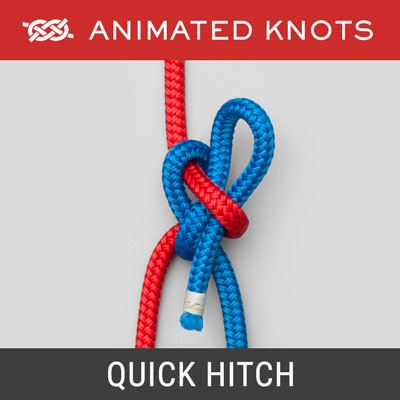
Arborist's method of pulling one rope aloft using another.
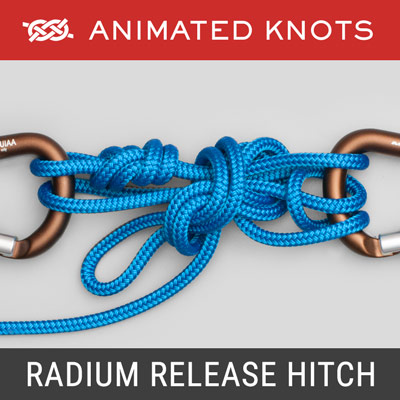
Allows a load to be transferred from one rope to another
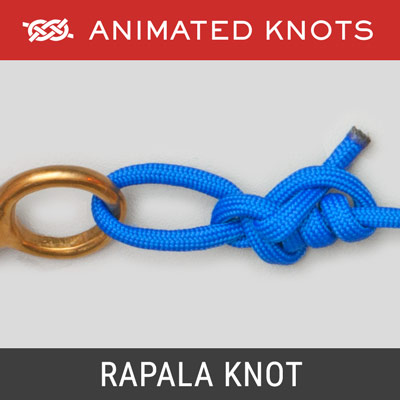
A non-slip loop knot usually tied directly to the lure.
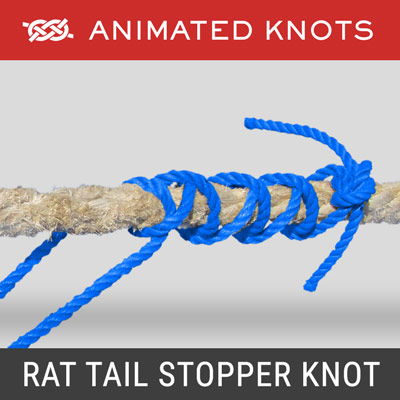
Takes a mooring line's load during transfer to the Bitts
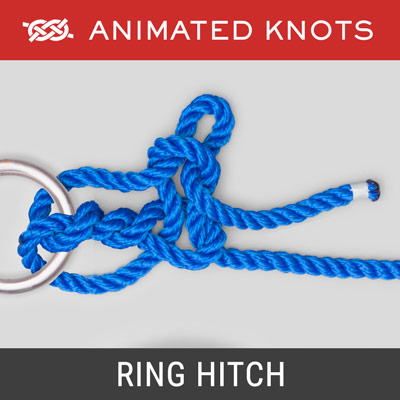
Effective rapid-release knot used to tie a horse to a ring.
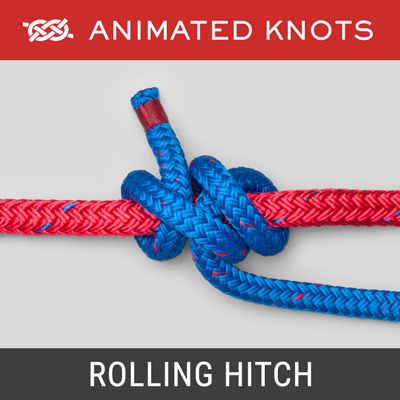
Popular slide and grip knot, may fail with modern ropes.
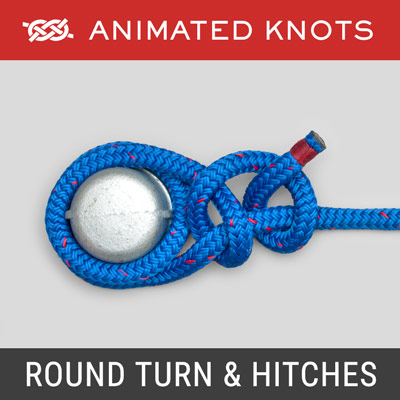
Excellent way of securing a rope to a post or ring.
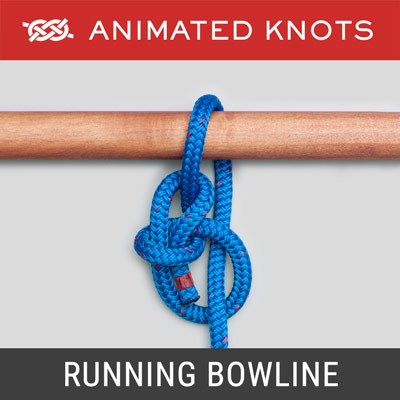
Bowline encircles the standing end to create a noose.
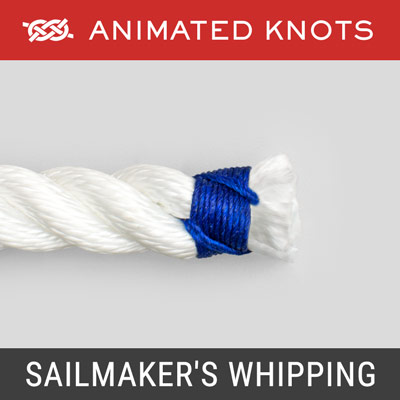
Secure method to prevent rope ends from fraying.
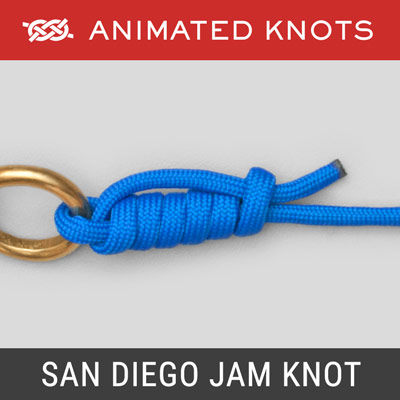
Attaches a hook to a line; retains line strength very well.
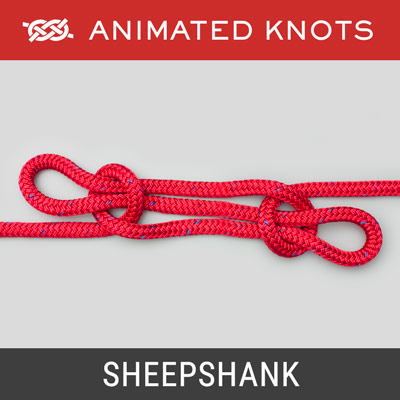
Unreliable knot used to shorten a length of rope.
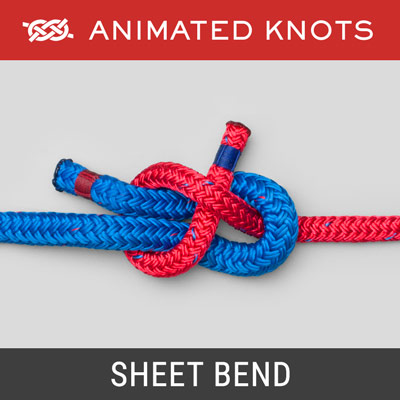
Joins two ropes of unequal, or similar, size

Binding slip knot commonly used to secure laced shoes
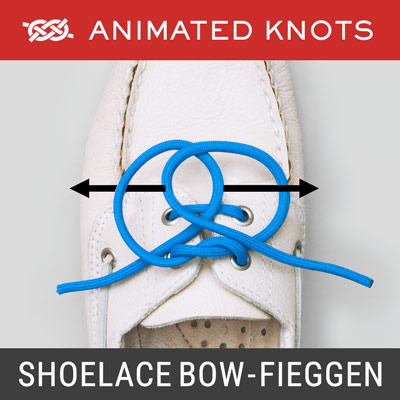
Quick and conveniently tie a bow to secure shoe laces.

Uses two Surgeon's Half Knots to form Shoelace bow.
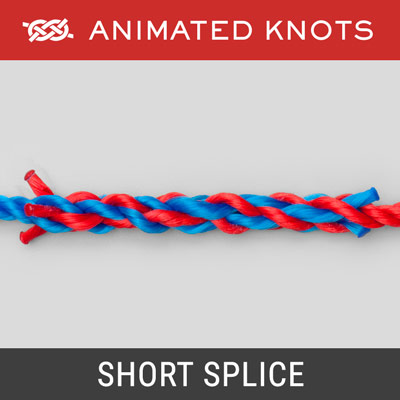
Makes a secure join between two pieces of stranded rope.
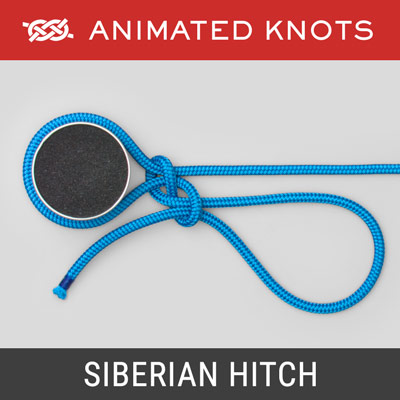
Quick-release hitch. May be tied in cold weather with gloves.
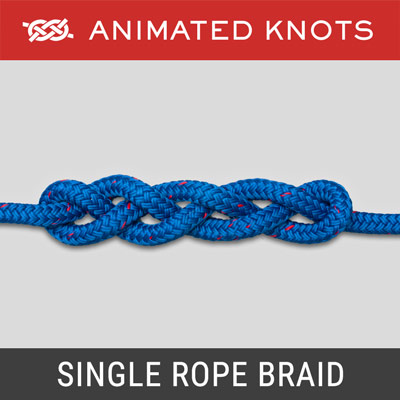
Demonstrates three-stranded braiding using a single rope.
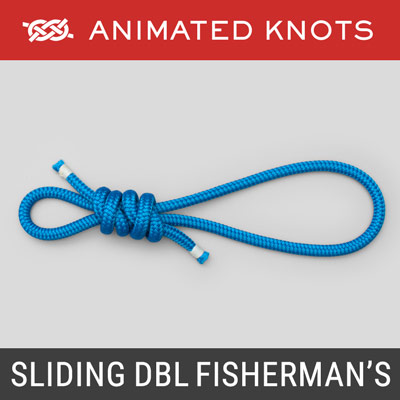
Creates a Prusik Loop with an adjustable length eye.
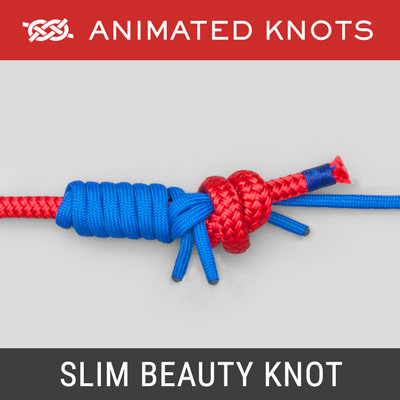
Excellent for joining lines of different diameter or material.
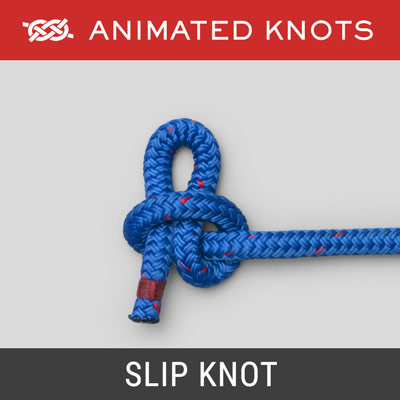
Simple loop in rope's end - loosens when tail end is pulled.
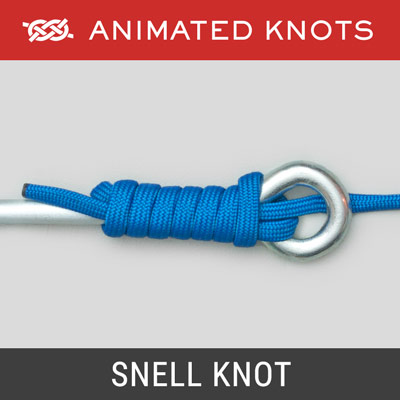
Allows the leader, or tippet, to be directly tied to a baited hook.
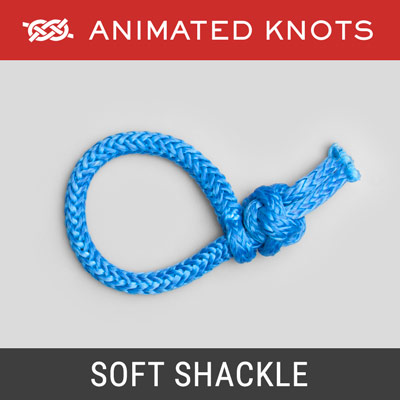
Neat method of creating a soft shackle in hollow-braid rope.
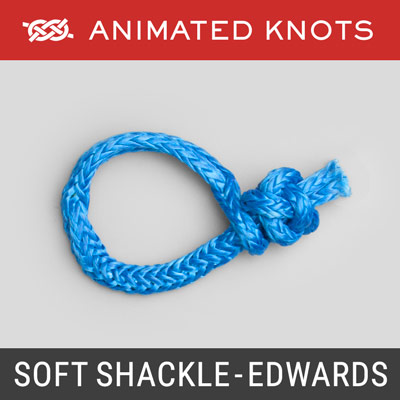
Edwards style shackle made out of hollow-braid rope.
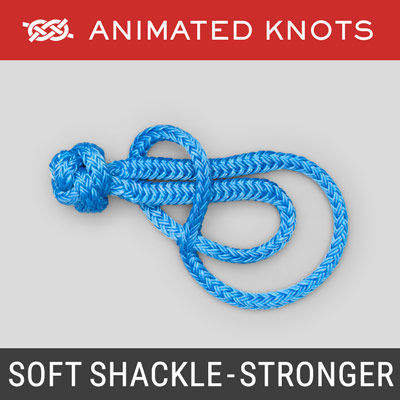
Stronger soft shackle made out of hollow-braid rope.
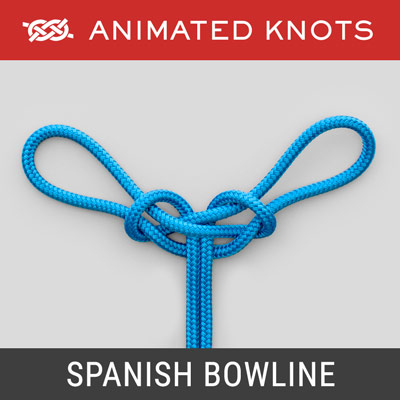
Creates two loops for tying around legs in an emergency
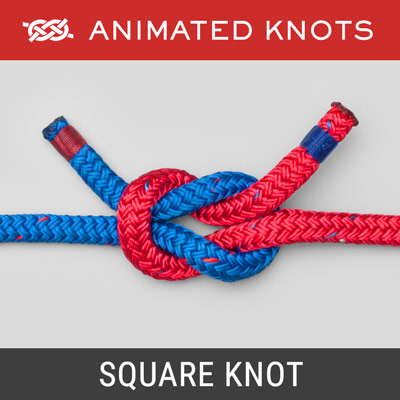
Simple way to join two ropes made up of two Half Knots.
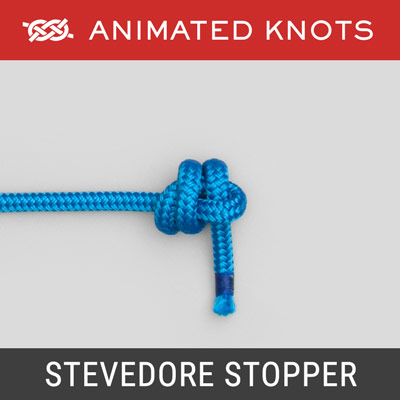
Intermediate size stopper using one more turn than the figure 8.
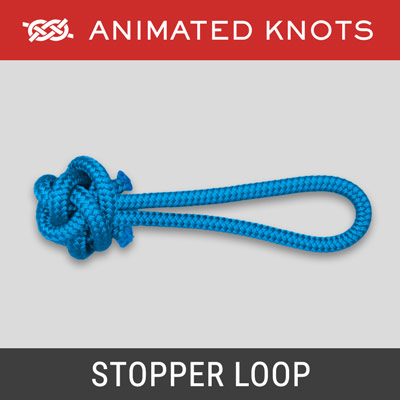
Loop that uses the Button Knot for the Stronger Rope Shackle
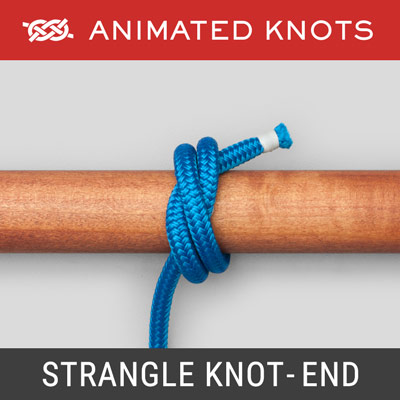
Moderately reliable to secure a bag or a fraying rope's end.
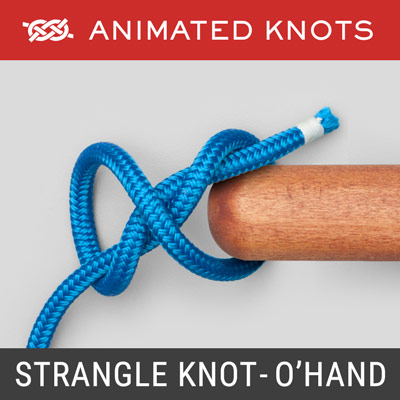
Secure method to control the descent of a heavy load.
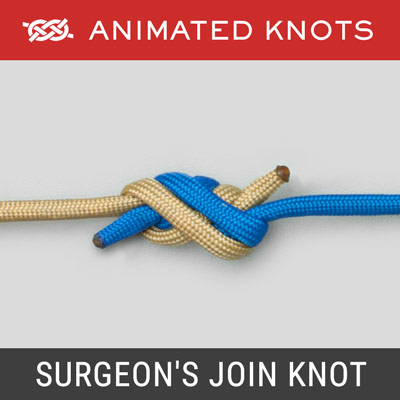
Reliable way to join two lines of moderately unequal size.
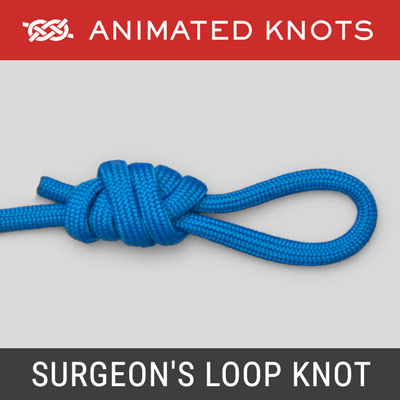
End of line loop often used to make a loop-to-loop connection
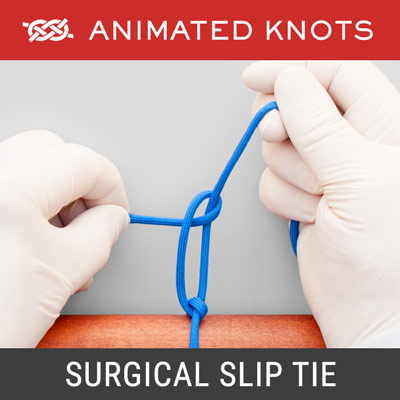
Allows knot to be slid down into the wound and then tightened.
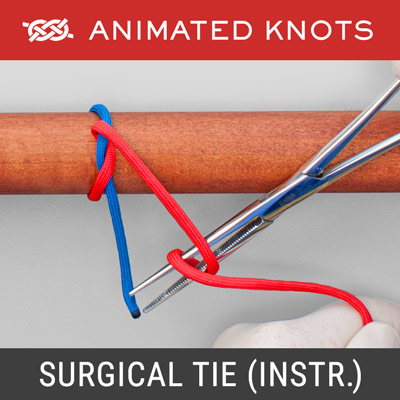
Shows a simple Square Knot being tied with forceps.
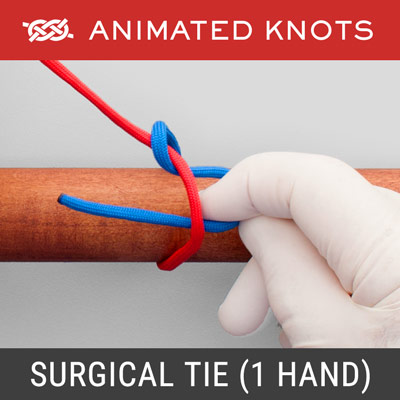
Standard One-Handed knot used by surgeons.
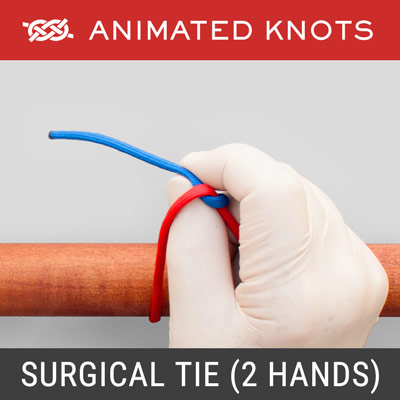
Standard Two-Handed knot used by surgeons.
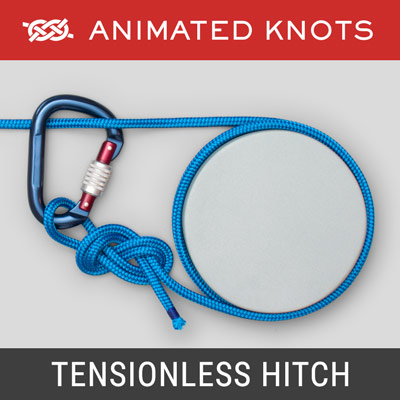
Simple wrapping hitch used in rescue work or rappelling.
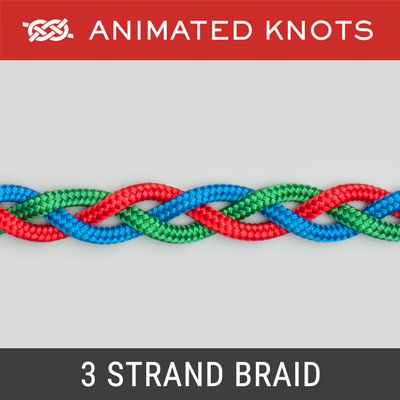
A three strand braid, the version usually used to braid hair.
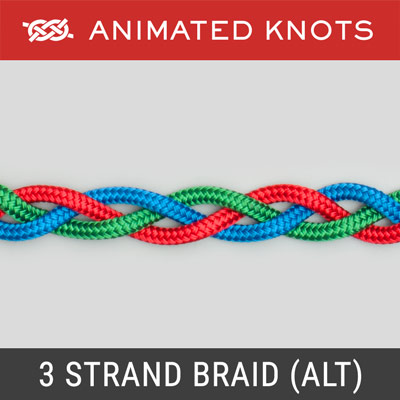
Simple braid but not the version usually used for braiding hair.
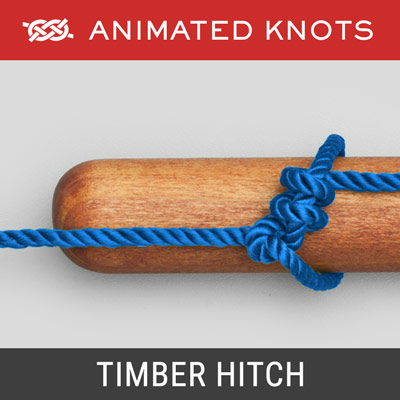
Simple knot commonly used for towing a log.
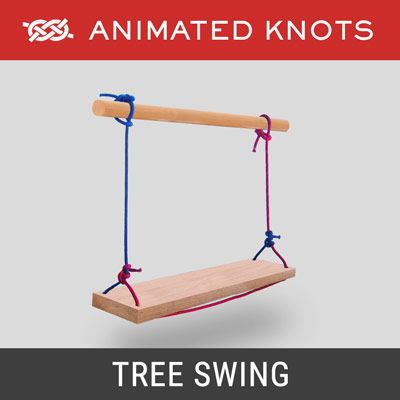
Shows how to tie knots to support a swing.
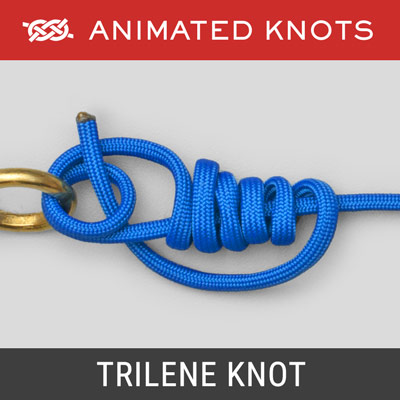
Strong and reliable knot to join monofilament line to hooks.
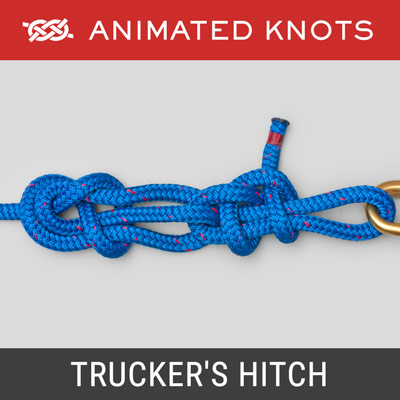
Valuable knot usually used for securing loads or tarpaulins.
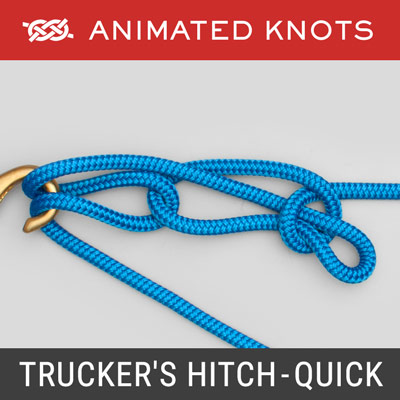
Quick-release method of securing a load or tarpaulin.
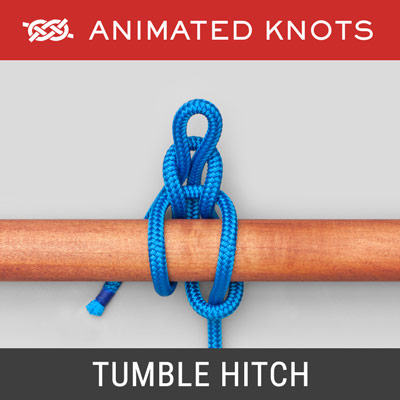
Quick-release hitch; released by a pull on the free tail.
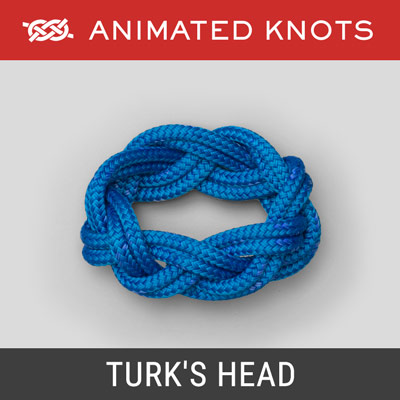
Creates a decorative braid around a pole or scarf.
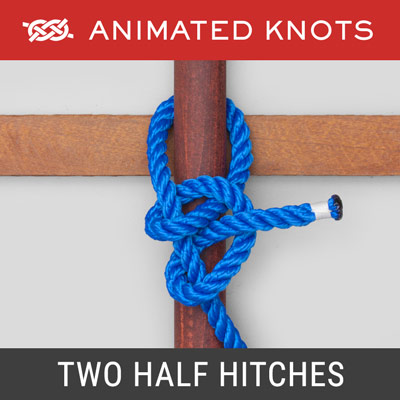
Used to secure an animal or an item to a ring, bar or pole.

A two-strand crown knot; prevents tension on terminals.
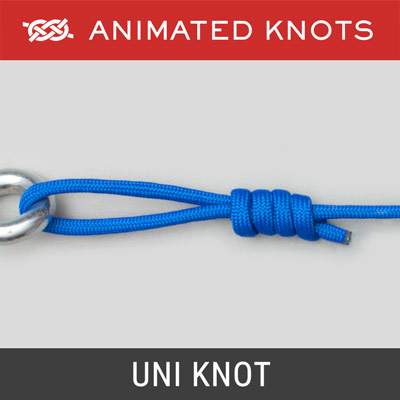
Used for Snelling, creating loops and end-to-end joins
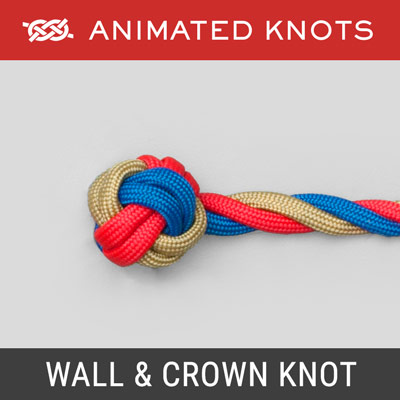
Creates neat compact ball at end of three-strand rope.
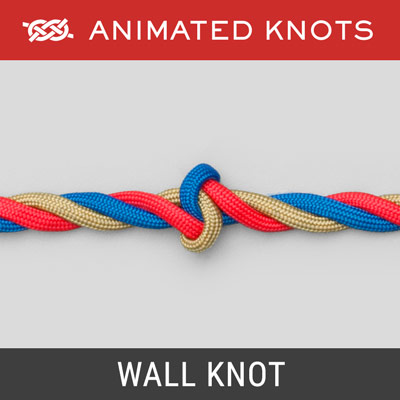
Component of other decorative knots or a small Stopper Knot.
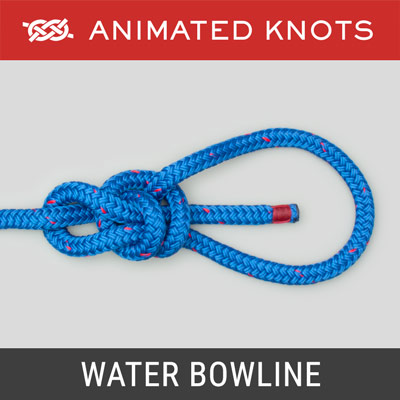
A Bowline with an additional turn for greater security.
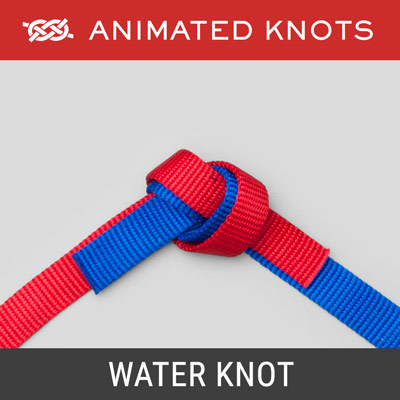
Joins two pieces of webbing strapping by re-threading.
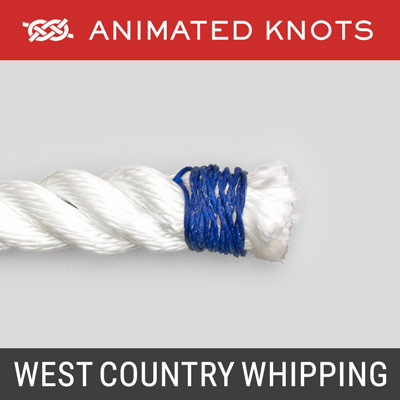
Simple whipping to prevent end of rope from fraying.
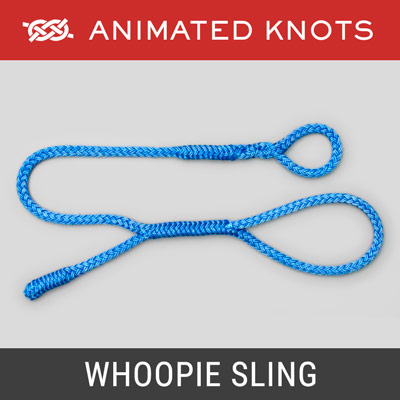
Creates a lightweight adjustable rope sling,

Produces a bulky, symmetrical, Necktie Knot.
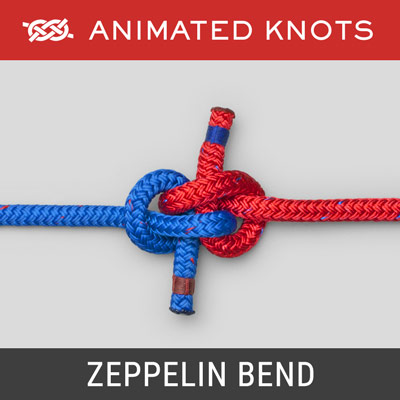
Joins two ropes and avoids the risk of jamming.
Yachting World
- Digital Edition

54-knot winds severely deplete 2024 Round the Island Race fleet
- Helen Fretter
- June 15, 2024
Extreme conditions severely depleted the fleet of the 2024 Round the Island Race, with hundreds of boats opting not to compete or retiring in 50-knot winds

Competitors in today’s 2024 Round the Island Race , an annual 50-mile circumnavigation of the Isle of Wight, faced one of the most severe conditions in years with gusts of over 50 knots recorded at The Needles, the westernmost point of the course.
The Round the Island Race traditionally attracts one of the largest fleets of any yacht race, and this year saw 939 boats originally entered.
However, today’s extreme conditions have severely depleted both the number of starters and finishers, and just 153 yachts completed the race with 418 retiring.
First to complete the course was Irvine Laidlaw’s Gunboat 80 Highland Fling , which posted an impressive elapsed time of 3h 39m 5s.

The Gunboat 80 Highland Fling was first multihull in the 2024 Round the Island Race Photo: Paul Wyeth/RTIR
Owner Irvine Laidlaw said: “It was the first event for us in 2024 and we’ve travelled over 3,000 miles from Palma to be here but it’s worth it! I thoroughly enjoyed the race – I like the fact we go around an island with the start and finish in the same place, it’s rather satisfying.”
Boat captain Xavier Mecoy added: “[The] Boat is only a year old and it’s the first time we’ve sailed her in a big breeze, we’ve never had 2 reefs in the main before, so that was pretty exciting and we spent quite a bit of time sailing bare-headed as it was safer.
“We were charging around the course doing 30 knots of boat speed at times.”
First monohull around was the Cowes based TP52 Notorious , owned by Peter Morton, who finished more than 40 minutes ahead of the nearest monohull yacht in 4h 21m 20s.
Notorious also finished 1st overall in IRC on correcrted time, winning the coveted Gold Roman Bowl.
Peter Morton, owner and skipper of Notorious, said: “I’ve not had the boat that long but I’ve competed in Round the Island Race many times over the last 50 years in various boats I’ve owned.
“It’s one of the most famous yacht races in the World and we went out to try and win. It’s 40 years ago since I won it on a little 25ft boat called Odd Job , so today was very special for me.”

Peter Morton’s TP52 Notorious took monohull line honours and 1st overall under IRC in the severe conditions of the 2024 Round the Island Race Photo: Paul Wyeth/RTIR
54 knots at the Needles
Despite a deceptively sunny start as the first fleets set off from the Royal Yacht Squadron at 0600, conditions quickly deteriorated to become even more extreme than many forecasts had suggested. The Needles Battery wind station (above the famous rock formation) recorded gusts of 54 knots from 0700 and a steady wind of 39-45 knots from the south-west. Competitors reported 35-40 knots going through Hurst Narrows.
This led to a severe sea state on the south of the island which saw many boats which had started choosing to turn back before the Needles. Fewer than 100 boats in the IRC and ISCRS fleets (the majority of monohulls) were recorded as rounding the Needles.
Many of those retiring have reported sail damage, particularly torn mainsails. There was a collision off Yarmouth, and at least one man overboard incident, which was recovered swiftly. However, organisers report that there were just nine other incidents – fewer than in previous years. Local RNLI and Independent Lifeboat crews were on the water across the Solent and on the south of the island supporting the fleet throughout the day.
David Rolfe, skipper of the Sigma 33 Shadowfax was one boat whose race ended by the Needles. Shadowfax was welcoming her new part owners aboard for their very first race on the boat.
“We started with a reef and our Number 2 [jib],” explained Rolfe. “It was, I would say deceptively – not calm, but quieter than forecast. When we came off the line, and if anything, it then dropped a little bit. As we headed down the Solent we even had a little bit of a talk about how we might set the spinnaker lines for when we’re on the south side of the island.
“Then a weather band that came in, a whole load of rain squalls, and that just changed mode completely. Suddenly we were in full on, probably 30-odd knots, gusting high 30s. It was a bit on and off through those squalls, some heavy rain, maybe even a little bit of hail in amongst it.
“The sea state was a bit rough, but not crazy. And then as we got towards Hurst, it went up another level. We could see it coming down the track towards us, and a few boats were really on their ear. One boat was definitely 45 degrees or more over, out of control, just pushed on its side by the wind. So we were battened down and gearing up for that.
“Then we got pushed right on our ear. We’d trimmed the main out. We’re trying to control it, but we were right on our side and going slowly, and almost sideways! I don’t know the wind strength, probably gusting into the 40s. And the sea was getting bigger and rougher with wind over tide really driving it pretty hard. So we decided we needed to go for a second reef, put that in. And after putting that in [we] tacked off to go into the full [tidal] stream through Hurst.
“That’s when we saw, unfortunately, we’d ripped our main, probably as we were reefing it. That was the end of the race for us. We bore away and hurtled back, surfing down these waves on our way back to Cowes.”

The Needles recorded winds of 54 knots as the 2024 Round the Island Race fleet passed the landmark. Photo: Paul Wyeth/RTIR
2024 Round the Island fleets cancelled
The race typically attracts a large cohort of family and amateur crews, for many of whom this is the only race they may compete in all year. A building forecast over the preceding week had led many competitors to withdraw ahead of the race.
The day before, organisers had also announced that eight classes would not start . Racing was cancelled for the Classic Racing Yacht (ISCRS), Diam 2 class, Gaffers under 23ft, J/70s, both divisions of Bridgedeck Multihulls, the smaller Grand Prix and MOCRA Multihulls, and the Sportsboat division.
Race safety officer Mark Southwell said on Friday 14 June, when making the announcement: “We will only cancel fleets where there is a significant chance that the majority of the fleet could get into difficulties and risk injury to the crew, a situation that could quickly overwhelm the support services.
“For other fleets, with a wide range of crew experience and boat types, it is each skipper’s sole responsibility to evaluate the capability of their crew and the suitability of their boat to handle the expected conditions (including wind and sea state) and make the decision as to whether their boat should take part.”
Race Director, Dave Atkinson said in a statement from the organisers after the race: “This race was a challenge for both the competitors and the Race Team at the Island Sailing Club, with the safety and well-being of the crews being the main priority.”
“We would like to thank the RNLI, independent lifeboats and coastguard teams for their assistance and co-operation before and during the race on Saturday. Despite the challenging conditions we only had nine incidents connected to the race which is less than previous years, this shows the seamanship of the crews and the correct decision making that went into undertaking of the race.”

Boats' Daily Knots: How Fast?
- Last updated Jun 18, 2024
- Difficulty Beginner
- Category Travel

The speed of a boat is measured in knots, which is the number of nautical miles per hour. The speed of a boat depends on various factors, such as the length of the boat, the conditions of the wind, and the sailing ability of the crew. On average, sailboats can sail up to 100 nautical miles in one day when running downwind. A boat's speed can also be affected by the use of its engine, which can increase the distance travelled by 20-40%. Larger boats can also cover more distance due to their length. For example, a 35-45-foot sailboat can travel 144 nautical miles in 24 hours with an average cruising speed of 6 knots.
| Characteristics | Values |
|---|---|
| How speed is measured | By counting the number of knots that pass the ship's stern in a given amount of time |
| Nautical mile definition | 1.15 statute miles (1.85 kilometres) or one minute of latitude |
| Nautical mile standardisation | 1929 internationally; 1954 in the US; 1970 in the UK |
| Average sailboat speed | 6 knots |
| Average sailboat cruising speed (under 32') | 5 knots |
| Average sailboat cruising speed (32'–48') | 6 knots |
| Average large yacht cruising speed (over 50') | 7.5 knots |
| Average sailboat speed (30–40 feet) | 4–7 knots |
| Average sailboat speed (40–50 feet) | 5–8 knots |
| Average distance travelled by a sailboat in 24 hours | 144 nautical miles |
| Average distance travelled by a sailboat in 24 hours at 5 knots | 120 nautical miles |
| Average distance travelled by a sailboat in 8 hours at 6 knots | 50 nautical miles |
| Average distance travelled by a sailboat in 8 hours at 7.5 knots | 60 nautical miles |
What You'll Learn
Average sailboat speed: 5-8 knots, speedboat speeds: 43-70 knots.
- How wind conditions affect speed?
Hull length and cruising speed
- How to calculate top speed?

The speed of a sailboat depends on several factors, including the type of boat, wind conditions, and the purpose of the sailing activity.
The average speed of a sailboat is between 4 and 15 knots, but this can vary depending on the size and type of boat, as well as other factors. For example, racing sailboats are designed to reach maximum speeds, while larger and bulkier sailboats may be slower due to drag and friction.
A sailboat with a monohull, which is the most common type, will typically have an average speed of 6-8 knots. Monohulls are displacement hulls, which means they are under the water, pushing the water away and cutting through it smoothly. This stabilizes the boat. To increase the speed of a monohull, the entire hull would need to be raised above the water.
On the other hand, sailboats with catamaran and trimaran hulls are planing hulls, which means they sit on top of the water. This makes them faster than monohulls, with average speeds of 9-10 knots. However, planing hulls are less stable than displacement hulls, so catamarans and trimarans have two or three hulls to increase their buoyancy.
The length of a sailboat also affects its speed. As a rule of thumb, the longer the boat, the faster it can go. This is because a longer boat creates longer waves, which allow it to move faster.
Other factors that can impact a sailboat's speed include the wind direction and speed, tide and currents, crew experience, and the condition of the boat.
To calculate the average distance travelled by a sailboat in a day, you can multiply the average speed in knots by the time in hours. This will give you the distance covered in nautical miles.
For example, a sailboat with an average speed of 6 knots can travel 144 nautical miles in 24 hours. If the average speed is reduced to 5 knots, the same sailboat will cover 120 nautical miles in 24 hours.
So, a sailboat with an average speed of 5-8 knots can travel between 100 and 180 nautical miles in a day, depending on various factors.
When is it safe for mom and baby to travel after birth?
You may want to see also
Speedboats designed for speed can reach high speeds of up to 90 mph on calm, flat waters. These boats are often called cigarette boats due to their slender shape.
Now, focusing on the speed range of 43-70 knots, we can assume that the speedboat in question is not one of the high-speed cigarette boats, but a more common recreational speedboat.
At 43 knots, a speedboat is travelling at about 50 mph, which is a comfortable speed for cruising and can be achieved by boats in the price range of many families, such as the Pursuit SC 365i Sport Yacht.
At the higher end of our speed range, 70 knots is equivalent to about 80 mph. This is an impressive speed for a recreational boat and would be the top speed of a powerful speedboat.
It's important to note that speed limits for boats vary depending on the type of waterway, time of day, boat type, and other factors. In no-wake zones, boats must travel slowly enough not to produce a large swell, which is usually below 5 mph.
When planning a trip, it's crucial to consider not just the top speed of your boat but also its average speed and fuel efficiency, especially if you're covering long distances.
Additionally, factors such as hull length, sail area, tide and currents, weather conditions, and crew experience can all impact the actual speed of your boat on the water.
In favourable conditions, a speedboat in this speed range could cover a large distance in a day. For example, at an average speed of 6 knots, a sailboat can travel 144 nautical miles in 24 hours.
Exploring the Sunshine State: Should We Travel to Florida This Weekend?
How wind conditions affect speed.
The impact of wind conditions on a boat's speed is influenced by factors such as the vessel's make and size, hull type, and the skipper's skill and experience. Wind can affect both the speed and direction of a boat, and understanding how to respond to varying wind conditions is a skill that even experienced boaters need to develop over time.
Light Winds
Light winds, ranging from 0 to 12 mph (0-10 knots), are considered ideal for most boating activities, including sailing, fishing, and cruising. These conditions are suitable for small boats and beginner operators.
Moderate Winds
Moderate winds, ranging from 13 to 24 mph (11-21 knots), can be handled with ease by experienced boaters, but small boats may become unstable. Sailors may find these conditions challenging but still manageable.
Strong Winds
Strong winds, ranging from 25 to 38 mph (22-33 knots), require caution for all types of boats. Small boats are particularly vulnerable to high waves and instability in these conditions. While experienced captains operating large boats can still venture out, they face an increased risk.
Very Strong Winds
Very strong winds, ranging from 39 to 54 mph (34-47 knots), are considered unsafe for recreational boating. Only experienced captains operating large boats should consider navigating in these conditions.
Dangerously Strong Winds
Winds exceeding 55 mph (48+ knots) are deemed too dangerous for boating. In such conditions, all vessels are advised to avoid taking to the water.
The shape and size of the boat's hull also play a crucial role in how it handles wind conditions. Boats with high hulls and large flybridges will be more affected by the wind and tend to rock wildly compared to boats with lower profiles and thicker hulls.
Additionally, the body of water being navigated can influence the impact of wind. On smaller bodies of water, where waves are typically smaller, an aerodynamic boat with a small surface area performs better in high winds. Conversely, on larger bodies of water, heavier boats with the capacity to handle large waves are more suitable.
Understanding true wind speed, which measures the actual speed of the wind over the water's surface, and apparent wind speed, which is the wind speed relative to the boat's speed and direction, is also essential for sailing vessels. While true wind speed is included in weather forecasts, apparent wind speed is more useful for sailing as it can help yachts sail faster.
In summary, wind conditions have a significant impact on a boat's speed and handling, and boaters must be responsive to these conditions to ensure a safe and enjoyable experience on the water. Checking wind and wave conditions before departure is crucial, regardless of the size of the boat or the skill level of the skipper.
Does the Flu Travel From China? Understanding the Global Spread of Influenza
The speed of a boat is measured in knots, which is the number of nautical miles travelled in one hour. A boat's cruising speed is affected by its hull length. The longer the boat, the higher the potential maximum hull speed, due to increased water length.
Hull speed, or displacement speed, is the speed at which the wavelength of a vessel's bow wave is equal to the waterline length of the vessel. As a boat's speed increases, the wavelength of the bow wave increases, and usually, its crest-to-trough dimension (height) increases as well. When hull speed is exceeded, a vessel in displacement mode will appear to climb up its own bow wave.
Hull speed can be calculated using the formula:
> Hull speed = 1.34 x square root of the waterline length (in feet)
For example, a 41-foot sailboat with a waterline length of 32.75 feet would have a hull speed of just above 7.6 knots.
The hull speed of a boat determines its maximum speed, as travelling faster than the hull speed requires more and more thrust, resulting in smaller gains in speed as more energy is wasted.
However, it is important to note that hull speed is not the optimal speed for all boats. For non-planing boats, a lower speed that minimises wave-making resistance and maximises fuel or power efficiency may be more desirable. Additionally, hull speed is not used in modern naval architecture, where considerations of speed/length ratio or Froude number are considered more helpful.
The Best Places to Travel From London and Explore
How to calculate top speed.
To calculate the top speed of a boat, you need to know a few factors. These include the boat's shaft horsepower, its displacement, and the Crouch Constant, which varies depending on the type of boat.
Horsepower is a measure of energy, with 1 horsepower equalling 550 foot-pounds per second or 746 watts. Displacement, meanwhile, refers to the volume of water displaced by the boat, which is then converted to weight. In practical terms, displacement is the weight of the boat.
The Crouch Constant is a value used in Crouch's formula, which is used to calculate the top speed of a boat. The formula is:
> S = Speed = √(P / D) × C
Where S is the boat speed, P is the shaft horsepower, D is the displacement, and C is the Crouch Constant.
The Crouch Constant depends on the type of boat and is applicable to a wide variety of boats, from cruisers to racing boats. For example, a racing catamaran has a Crouch Constant of around 230, while an average runabout has a Crouch Constant of around 150.
By plugging in the values for shaft horsepower, displacement, and the Crouch Constant into Crouch's formula, you can calculate the top speed of a boat in knots.
It is important to note that the top speed of a boat can be influenced by various factors such as horsepower, propeller slip, the condition of the boat, and water conditions. Additionally, reinforcing the hull and transom may be necessary if you plan to increase the horsepower of your boat to prevent damage and ensure safety.
Essential Items for H1 Visa Travel: What You Should Bring
Frequently asked questions.
A boat travelling 100 miles per hour is going about 86.96 knots.
Speedboats can typically reach speeds up to 70 knots. The conversion between knots and mph is: miles per hour = knots × 1.1507794.
On average, sailboats can sail up to 100NM (that is 115 miles or 185km) in one day when they run downwind. If you use the engine, the distance can increase to 130NM if you travel longer.

- Susan Meyers Author

- Annie Rangel Author Editor Reviewer
It is awesome. Thank you for your feedback!
We are sorry. Plesae let us know what went wrong?
We will update our content. Thank you for your feedback!
Leave a comment
Travel photos, related posts.

Understanding Eligible Travel for the Costco Visa: A Comprehensive Guide
- Mar 14, 2024

Exploring the Cosmos: A Guide to Travelling Beyond the Solar System with Galacticraft
- May 08, 2024

Tips for Demonstrating Financial Stability for a Travel Visa Application
- May 05, 2024

Exploring the Northern Region: A Solo Traveller's Journey

Understanding the Traveller Number in Etihad Airlines
- Jun 03, 2024

Exploring the Travel Experiences Florida Has to Offer
- May 14, 2024

6 Essential Knots For Every Outdoorsman to Know
Posted: June 23, 2023 | Last updated: June 23, 2023

Every outdoorsman knows that preparation is key to a successful adventure. Whether you plan on camping, fishing, hiking, or any other outdoor activity, one of the most important skills you can have is the ability to tie knots. Knots are essential for securing gear, setting up shelters, and even saving lives in emergency situations.
However, with so many different knots out there, it can be overwhelming to know which ones to focus on. That's why we've put together a list of the 6 essential knots that every outdoorsman should know. From the simple square knot to the more complex bowline, these knots will help you tackle any situation that comes your way.
We'll provide step-by-step instructions for each knot and explain when and where to use them. By the end of this article, you'll feel confident in your knot-tying abilities and be ready to tackle any outdoor adventure with ease. So whether you're a seasoned outdoorsman or just starting out, read on to learn the 6 essential knots you need to know.
The Bowline Knot
The bowline knot is a versatile and reliable knot used in a variety of situations. It is commonly used in sailing, rock climbing, and rescue operations.
Here is a step-by-step guide on how to tie the bowline knot:
- Create a small loop with the rope and hold it in your left hand, with the working end of the rope (the part you will be tying the knot with) hanging down.
- Take the working end of the rope and pass it up through the loop.
- Bring the working end of the rope behind the standing part of the rope (the part that is not being used to tie the knot).
- Pass the working end of the rope back down through the loop.
- Tighten the knot by pulling on the working end of the rope and the standing part of the rope.
The bowline knot is a reliable knot that creates a secure loop that will not slip or come undone. It is often used in situations where a secure loop is needed, such as when tying a rope to a tree or post or when hoisting a person or object.
One important thing to note about the bowline knot is that it can be difficult to untie after it has been loaded. This means that if the knot has been under tension, it may be difficult to untie and could require cutting the rope.
Overall, the bowline knot is a versatile and useful knot that should be included in every outdoor enthusiast's repertoire. With a little practice, it can be tied quickly and easily, providing a secure loop that can be trusted in a variety of situations.

The Square Knot
The square knot, also known as the reef knot, is a simple yet versatile knot used to join two ropes or cords of equal diameter. It is commonly used in various activities such as camping, sailing, fishing, and climbing.
To tie a square knot, follow these steps:
- Take two ropes and cross one over the other to create a loop.
- Take the end of the rope that is now on top and pass it underneath the other rope and through the loop.
- Pull the ropes tight to form the first half of the knot.
- Cross the other rope over the first rope to create a second loop.
- Pull both ropes tight to complete the square knot.
It is important to note that the square knot should only be used to join two ropes of equal diameter. If the ropes are of different sizes, the knot may slip or come undone.
The square knot is commonly used to tie two ropes together for various purposes, such as securing a load, tying a knot in a rope, or securing a sail. It is also used as a binding knot to tie off the ends of a rope.
One of the advantages of the square knot is that it can be easily untied after it has been tightened. This makes it a great knot for situations where you may need to adjust or release the knot quickly.
The square knot is a simple and versatile knot that is useful in a variety of situations. With a little practice, you'll be able to tie it quickly and confidently.

The Clove Hitch Knot
The clove hitch knot is a simple and versatile knot that can be used in a variety of situations.
To tie the clove hitch knot, follow these steps:
- Start by making a loop in the rope.
- Take the end of the rope and pass it over the loop, then under and over the standing part of the rope.
- Pull the end of the rope tight to secure the knot.
The clove hitch knot is commonly used for tying a rope to a post or pole, as it can be easily adjusted and is secure under tension. It is often used in boating to tie a boat to a dock or to secure a fender to a rail. The knot can also be used in camping to secure a tarp or tent.
One of the advantages of the clove hitch knot is that it can be easily untied, even after being under tension. This makes it a good choice for situations where the knot may need to be adjusted or released quickly. However, it is not recommended for situations where the knot may be subject to sudden shocks or changes in tension, as it can slip or become unstable.
The clove hitch knot is a useful and easy-to-learn knot that can be used in a variety of situations. Whether you're boating, camping, or just need to secure a rope, the clove hitch knot is a reliable choice that you can count on.

The Taut-Line Hitch Knot
The taut-line hitch knot is a versatile knot that is commonly used in camping, hiking, and other outdoor activities. It is a type of adjustable knot that can be used to secure a rope or cord to a fixed object, such as a tent stake or tree, while allowing for easy adjustment of tension.
To tie the taut-line hitch knot, follow these steps:
- Start by wrapping the rope around the fixed object and bringing it back to the standing end.
- Then, tie a half hitch around the standing end and pass the working end through the loop created by the half hitch.
- Next, make a turn around the standing end and pass the working end through the loop again.
- Finally, tighten the knot by pulling on the working end while holding the standing end.
The taut-line hitch knot is ideal for situations where the tension on the rope or cord may need to be adjusted frequently, such as when setting up a tent on uneven ground. It is also useful for securing loads on vehicles or tying down tarps or other coverings.
One important thing to keep in mind when using the taut-line hitch knot is that it can slip under heavy loads or if the rope becomes wet or dirty. To prevent slipping, it is important to ensure the knot is tightened properly and periodically check it for slippage.
The taut-line hitch knot is a valuable tool for anyone who spends time outdoors and needs a reliable way to secure ropes and cords. With a little practice, it can be easily mastered and will prove to be a valuable addition to any outdoor enthusiast's skill set.

The Sheet Bend Knot
The sheet bend knot is a useful and versatile knot that is commonly used in boating, camping, and other outdoor activities. It is used to join two ropes of different sizes or materials, and is particularly useful when the ropes are of unequal thickness.
To tie the sheet bend knot, follow these steps:
- Make a bight (a loop) in one rope and hold it in your left hand.
- Pass the other rope through the bight from behind and bring it up over the top of the bight.
- Take the end of the second rope and pass it under the bight and back over itself.
- Pass the end of the second rope under the loop of the first rope.
- Pull the standing parts of both ropes to tighten the knot.
The sheet bend knot is a strong and secure knot that is ideal for joining ropes of different sizes or materials. It is also easy to tie and untie, making it a popular choice for many outdoor enthusiasts.
One of the main advantages of the sheet bend knot is that it can be used to join ropes of different thicknesses. This is because the knot does not rely on friction to hold the ropes together, but instead creates a secure interlocking mechanism between the two ropes.
Another advantage of the sheet bend knot is that it can be used to join ropes of different materials, such as nylon and natural fibers. This is because the knot does not put excessive stress on the ropes, which can cause them to break or fray.
The sheet bend knot is a versatile and reliable knot that is well-suited for a wide range of outdoor activities. Whether you are boating, camping, or just need to join two ropes together, the sheet bend knot is a great choice.

The Fisherman's Knot
The fisherman's knot, also known as the water knot, is a simple and strong knot that is commonly used in fishing and climbing. It is an essential knot for anglers, as it creates a secure connection between the fishing line and the hook or lure.
To tie the fisherman's knot, follow these steps:
- Start by overlapping two pieces of fishing line or rope.
- Take one of the ends and wrap it around the other line or rope 4-5 times, then pass the end through the loop that has been formed between the two lines.
- Repeat the process with the other end, wrapping it around 4-5 times and passing it through the loop in the opposite direction.
- Tighten the knot by pulling both ends in opposite directions until the knot is snug and secure.
The fisherman's knot is ideal for tying two lines of equal diameter together and is often used to attach leaders to fishing lines. It is also a popular knot for rock climbers, as it can be used to join two ropes together in an emergency situation.
One of the benefits of the fisherman's knot is that it is easy to tie and untie, making it a convenient choice for anglers who may need to change their lures frequently. However, it is important to note that this knot can weaken the fishing line, so it should not be used in situations where maximum strength is required.
The fisherman's knot is a versatile and reliable knot that every angler and climber should know how to tie. With a little practice, it can be tied quickly and securely, providing peace of mind and ensuring a successful day out on the water or up on the mountain.
More for You
WNBA Makes Major Announcement After Indiana Fever vs. Chicago Sky Game
Traffic lights could be getting a fourth colour
Cheese Recall Update as FDA Sets Most Severe Level
California achieves incredible new milestone with its power supply: 'It is the new reality'
A Jordan Spieth bathroom emergency led to a PGA Tour rule change on disqualifications
5 Common Mistakes People Make When Riding A Motorcycle
Shaquille O'Neal Made His Opinion of Angel Reese's Physical Play Extremely Clear
7 Habits That Will Drastically Improve Your Energy Levels
Centuries-old secret room discovered by joiner at Irish castle
7 Best Funds to Hold in a Roth IRA
8 foods you should never eat at a hotel breakfast
Winter Storm Warning for Two States as Heavy Snow To Hit
Texan builds stunning ‘passive house’ that uses 75% less electricity and literally makes him money: ‘The best way to build’
New paintings discovered in ancient city of Pompeii
Here’s What Those Little Black Dots on a Windshield Are For
Hydrogen train sets world record
Clip of Jill Biden being slammed on US talk show over husband’s track record is doctored
Tortilla Recall as FDA Sets Risk Level
What is the Median Household Income for the Upper Middle Class in 2024?
US House Passed Bill Automatically Registering Men 18-26 Years Old for Draft. Here's What That Means

June 17 , 2024
Y1S2.1 Patch Notes
Season 2 Chorus of Havoc is now in full swing. The Hubac Twins and their Chorus Fleet continue to bring chaos and target Helm assets. Update 2.1 brings plenty of content updates and bug fixes.
New Content
- "Endless Requiem" Torpedo - the blueprint is now obtainable by completing the contract "Melodic Mayhem".
- "Stormwoven Symphony" Armour - the blueprint is now obtainable by completing the contract "Curtain Call".
World Events
- Clan of Fara (recommended Ship Rank 4-5)
- Dominion of Rempah (recommended Ship Rank 6-7)
Gameplay Updates & Improvements
Manufactory defense rebalance.
- Reduced the recovery time for a damaged Manufactory (capped at 4 hours).
| Manufactory Level | Damage Recovery Time (hr) |
|---|---|
| 1 | 1 |
| 2 | 1 |
| 3 | 1 |
| 4 | 2 |
| 5 | 2 |
| 6 | 2 |
| 7 | 3 |
| 8 | 3 |
| 9 | 3 |
| 10 | 4 |
Call-for-help
- Players can now fast travel to events (e.g. Elite Warship, Bounties) from land or from sea, at a silver cost based on distance if they are not involved in combat, and are not participating in Helm opportunities, or other world activities like Helm Wager, Cutthroat Cargo, etc.
- Players can fast travel to plunderable POIs when responding to a call-for-help initiated by another player at no silver cost.
- Calls-for-Help: Players responding to a call-for-help initiated by another player can fast travel to the activity (e.g. World Event...) at no silver cost.
- Torpedoes are no longer destroyed when traveling through non-hostile minefields from a Springloader Buoy that is owned by yourself or another friendly (PVP-off) player.
- "A Smuggler's Way" - can also be triggered upon reaching Infamy Tier: Rover.
- "A Covert Initiation" - can also be triggered upon reaching Infamy Tier: Buccaneer.
- "The Horizon Beckons" - can also be triggered upon reaching Infamy Tier: Brigand.
Bounty Contracts
- Reduce the cooldown period of all Bounty Contracts to 30 minutes.
- "Anguish from the Abyss" can now be accepted from the Mysterious Rogue in The Oubliette outpost.
- "Jaws of Retribution" can now be accepted from the Sea People Huntmaster in Lanitra outpost.
- "Silent Death" can now be accepted from the Sea People Huntmaster in Lanitra outpost.
Added a new perk to the Dhow.
- "Out of Sight" Perk: Reduce detection by ships bigger than the Dhow.
Increased manoeuvrability of small ships:
- Increase speed of all small ships by up to 2 knots when sailing in favourable winds for at least 3 seconds.
- Increase turn rate of all small ships when at full sail, half sail and when trimming.
Ship Upgrades
- "Bow Upgrade" perk renamed to "Stations Upgrade".
- "Stations Upgrade", "Gunport Upgrade" perks (at upgrade step 1) no longer provide 5% reload time reduction but will instead provide 25% extra damage and healing output bonus on broadsides.
- Dev note: Enhanced small ship perks, making them more viable to offset the lack of gun ports particularly on the broadside.
- Dev note: This makes it easier for players with multiple ships of the same model to locate a specific ship to upgrade.
Damage Mitigation Reduction
EDIT: Will be available with update 2.1.2
- For example, by equipping these 2 items, Black Prince armour: 50% mitigation (when ship is at less than 33% health) + Iron Capstan furniture: 15% mitigation (when ship is anchored).
| Original calculation | New Calculation |
|---|---|
| 50% + 15% = 65% 65% damage mitigated | 100% - (100%-50%) x (100%-15%) = 57.5% 57.5% damage mitigated |
- Dev note: We have identified an issue where damage mitigation stacking was excessively high due to its additive formula. This led to scenarios where mitigation reached impractical levels, trivializing content and reducing the intended challenge. We are planning to make several balance changes, but we have decided to accelerate this particular fix due to its significant impact on the game.
Loot/ Rewards
- Players will no longer need to dock at a den to secure their Pieces of Eight obtained from Bronze, Silver and Gold Raider Caches.
World Events Timer
- Extended duration of Anguish from the Abyss, The Blighted Bastion, and Chorus of Havoc Elite Warships world events from 18 minutes to 30 minutes.
Added a tooltip in the Helm Overview menu to indicate when players own the maximum number of manufactories.
Added an Interface setting that controls the "Default Selection" in Journal.
- Tracked (default): When opening the Journal, the tracked objective is selected.
- Top: When opening the Journal, the first objective in the list is selected.
Added section in the tooltips to display possible rewards obtainable from a chest (displays up to 5 rewards from the list of potential rewards).
Updated Silver currency display in multiple menus to show values beyond 999999+.
Added details for when the next set of contracts in the subsequent episode are available.
Removed red indicator when viewing other equipment at the Vendors or at the Customization screen.
Darkened the sides of the main menu to increase contrast of Menu options and IGN article slots.
- Added "Chorus of Havoc" background music in the Main Menu.
- Fixed an issue where the "Raised Quarterdeck" did not correctly reduce incoming status effect damage.
- Fixed an issue where ship rank damage multipliers were not being applied when attacking towers and forts.
Helm Upgrade
- Fixed an issue where the "Master Distillers" upgrade does not work when player is offline.
Smuggler's Pass
- Fixed an issue where the "Freebooter Moustache" piece from the Versailles set was not unlocked even after unlocking the "Bourgeois Bundles" A and B from the Smuggler's Pass.
- The incorrect items: "Ornate Hakama" and "Yoroi Boots" will be replaced with the intended rewards: "Nightsong Pants" and "High Snap Boots".
- For players who have already redeemed their rewards, the replacement will take place in your Vanity inventory.
- Fixed an issue where the "Sealskin Boots" was missing from the Treasure Hunter set.
- Fixed the Helm Wager destination icon to be consistent with other PVP activities' icons.
- Fixed an issue where the penalty for failing a Manufactory Defense was not being displayed on the activity tooltip.
- Fixed an issue where the "Manufactory Under Siege" tooltip did not disappear after an unsuccessful Manufactory Defense.
- Fixed an issue where entering the Store from the Item Preview Screen causes an out of currency error message.
- Fixed inconsistent background that is displayed in the Manufactory Buyout tutorial during gameplay.
- Previews of cosmetic items that were planned to be released later in the season have been removed, it will be available on display when the vanity item is available at the Rotative Store.
- Fixed an issue where incorrect descriptions of the "Ebon Pirate Set" and the "Versailles Set" were displayed in the vanity atelier.
- Fixed an issue where Ship Upgrade requirements were displayed outside of the widget borders after tracking the blueprint.
- Fixed an issue where the recommended Ship Rank shown in the Journal does not match the contract target ships' Ship Rank.
Job Board Rewards
- Dev note: The job board chests were intended as a bonus to reward players who took on Jobs of a higher difficulty level.
- Fixed an issue where the contract "Plague and Poison" was not being triggered after completing the contract "Dressed to Kill".
- "The Pirate's Lament"
- "Dissonant Disappearance"
- "Rhapsody in Red"
- "Rhythemic Retrieval"
- "Ballad of Destruction"
- "Clashing Cadence"
- Dev note: the fix will be applied to newly generated contracts, and not to ongoing contracts.
- Fixed an issue where the repeatable contract "The Tow of Empire" was not available after completing Rahma's main contracts.
- Fixed an issue where the rewards of Job Board contracts located in the Red Isle were giving Silver chests instead of the Gold chests.
- Players are now no longer able to abandon the contract "A Shipwrecked Soul".
- Fixed an issue where a party member's contribution to the contract "Destroy DMC Towers" was not reflected in the UI of the contract.
- Fixed an issue where the contract "East Indies Delicacy" was rewarding less rewards than intended.
- Fixed an issue where the recommended ship rank of the contract "Symphony of Cannons" was lower than intended.
- Fixed an issue where the contract location of "Sable Refrain" and "Argent Refrain" was incorrectly displayed in the Journal.
- Fixed an issue where the Job board contracts "Hunt Merchants", and "Sink for Drugs" were highlighting an incorrect trade route.
- Fixed an issue where players receive "Joka Kubwa's Head" from sinking the first wave of reinforcements in the bounty contract.
- Fixed an issue where players were unable to discard contract items like "Ornate Special Ammo Crate" and "Escape Letter" after completing the respective contracts.
- Fixed an issue where the contract objective was not displayed after accepting the repeatable contract "In for Skins".
- Fixed an issue where the shared contract "Jaws of Retribution" was being persistently displayed on the group members' UI when the group leader leaves the group.
- Fixed an issue where the contract "Loadout: Bombard" does not update after players sink Rogue Warships that were spawned during Rival Hunts using bombards.
- Fixed an issue where the contract "Loadout: Mortars" does not update after players destroy the DMC towers.
- Fixed an issue where the recommended ship rank for the contract "Loadout: Mortars" is incorrectly displayed as 7 instead of 6.
- Fixed an issue where the contract "Steven's Ruby Tune" was displaying incorrect values on the objective tracker.
- Fixed an issue where the contract "Smugglers' Way" was not given on completion of the contract "Shadow of Spoils".
- Lowered the pre-requisite of the "Convoy of High Spirits" world event icon being displayed on the map from Infamy Tier Cutthroat to Infamy Tier Brigand.
Multiplayer
- Fixed an issue where accepting a group invite could redirect the player to the title screen instead of joining the group's server.
- Fixed an issue where players could see other players visually sunken into the ground.
- Fixed an issue where audio feedback was missing for pressing a button when picking up floating loot in the sea.
Localization
- Fixed an issue where the "Clear storage space to fund" message was missing in Polish and Spanish localizations.
Achievements/Challenges
- Fixed an issue where Time Limited Challenges were not showing the required quantity for challenges' objectives.
- Fixed an issue where achievements were being unlocked during the trial version.
Performance and Optimization
- Dev note: We are actively investigating the remaining stability issues on Xbox platforms.
- Improved stability for Ship Upgrade.
- General stability improvements.
- Fixed an issue where a frame rate drop was observed after spamming the Cycle inventory button while previewing ship vanities in the Shipwright.
- Fixed an issue where significant frame drops could be observed when submitting a contract.
- Fixed an issue where significant frame drops could be observed when sailing and fighting ships in the Open Seas region.
Recommended Content

Watch the latest trailer

- 672 Wine Club
- Motorcycles
- Car of the Month
- Destinations
- Men’s Fashion
- Watch Collector
- Art & Collectibles
- Vacation Homes
- Celebrity Homes
- New Construction
- Home Design
- Electronics
- Fine Dining
- Gateway Bronco
- On Location – Olympic Games Paris 2024
- One&Only
- The Ritz-Carlton, Kapalua
- Saratoga Spring Water
- Wynn Las Vegas
- Sports & Leisure
- Health & Wellness
- Best of the Best
- The Ultimate Gift Guide
This New 115-Foot Electric Sailing Catamaran Can Cruise the Seas Sans Emissions
Sunreef's new 35m eco is outfitted with custom batteries, electric engines, and solar panels., rachel cormack.
Digital Editor
Rachel Cormack's Most Recent Stories
Lürssen’s newest superyacht is a 269-foot tri-deck behemoth.
- Brad Pitt’s New Formula 1 Flick Will Hit Movie Theaters Next Summer
- King Charles Has 5 Horses Competing in Royal Ascot This Week
- Share This Article

Sunreef ’s lineup just got even bigger and greener.
Related Stories
- The New Audi E-Tron Is the Marque’s Most Powerful Production Car Ever
- Koenigsegg Tells Jesko Owners to Stop Driving the Supercar Because One Caught Fire

Spanning 115 feet, the newest composite multihull is fitted with Sunreef’s custom-engineered batteries and state-of-the-art electric engines. Solar panels will also be embedded into the hull sides, superstructure, and bimini, allowing the cat to generate power from the sun. The yard has previously added this patented “ solar skin ” to several models, such as the newly unveiled Explorer Eco 40 , the Eco 100 , the Zero Cat , and the 80 Power Eco .
Sunreef didn’t share any details regarding speed or range for the new 35M Eco, but the aforementioned 80-foot cat is powered by 360 kW electric motors that can push it to 10 knots. The newcomer theoretically has an “infinite range,” given it can continuously get power from the sun so long as it’s shining. The clean, emissions-free energy would also power the hotel load at anchor.

The 35M Eco is not only sustainable but also spacious and stylish. With a beam of 48 feet, the yacht offers expansive living areas onboard. Positioned in the bow of the main deck, the owner’s stateroom provides stunning panoramic views and private access to an outdoor terrace. The luxurious guest accommodation, meanwhile, is located in the hulls and is fully customizable.
The 35M Eco offers an abundance of alfresco lounging areas, too. The vast walkaround aft deck, which Sunreef calls the “ocean lounge,” gives seafarers easy access to the sea and a hidden garage stocked with water toys. In addition, the sprawling flybridge features a plunge pool and bar.
Rachel Cormack is a digital editor at Robb Report. She cut her teeth writing for HuffPost, Concrete Playground, and several other online publications in Australia, before moving to New York at the…
Read More On:
- Electric Yacht
- Sailing Yacht
More Marine

This 170-Foot Sportfishing Superyacht Is One of the World’s First—Here’s a Look Inside

This Sleek New 112-Foot Aluminum Superyacht Has an All-Glass Sky Roof

The World’s Largest Sportfishing Yacht Just Embarked on Its Maiden Voyage

The Grand UK Debut
JULY 17 - 19, 2024 Head to the British countryside to test and evaluate the top luxury and performance vehicles of 2024.
Give the Gift of Luxury
Latest Galleries in Marine

‘Haven’ Superyacht in Photos

Bluephire 34 in Photos
More from our brands, exclusive: in his first interview as bloomingdale’s ceo, olivier bron shares his vision for change, nets parent bse global valued at $6 billion as kochs land 15% stake, kendrick lamar’s ‘the pop out — ken and friends’ concert in los angeles to stream live on amazon music, carrie mae weems returns to ‘kitchen table series,’ this time with a$ap rocky, for bottega veneta, the best yoga mats for any practice, according to instructors.

IMAGES
VIDEO
COMMENTS
Boating Knot Characteristics. Rope used in boating is durable and expensive and is often handling heavy loads, e.g., when berthing, mooring, towing another vessel, preparing for a storm, or managing sails. The emphasis, therefore, is on safety, reliability, and convenience.
Clove hitch knot. 3. Bowline knot. This knot is highly versatile and one of the most popular knots, not just among mariners and sailors. Most commonly it is used to form a fixed loop at the end of a line. It's very secure, does not slip and, as a result, won't reduce the strength of the rope on which it is tied.
Form a closed loop in the line, with the working end passing over the standing end. Pass the working end through the loop, around behind the standing end, then back into the loop. Give a hard pull to close the knot up tight. To untie a bowline, turn the knot over and break its back by bending it downward. Stopper Knot.
4.3 The Cleat Hitch. The Cleat Hitch is a popular knot for securing a line to a cleat, a device used to secure ropes on a boat. It is simple to tie and untie, making it convenient for quickly securing lines during docking or mooring. The Cleat Hitch is an essential knot for maintaining control and stability in various sailing situations.
Double Half Hitch. Rolling Hitch. Clove Hitch. These knots form the foundation of maritime knot-tying, covering a wide range of boating, sailing, and general maritime activities. Mastery of these knots ensures readiness for most situations encountered on the water, enhancing safety, efficiency, and the overall maritime experience.
Here's a simple and easy guide to some boating knots everyone should know. Don't forget to subscribe: https://www.youtube.com/channel/UCEcFn6tlj_WpZCBBouZ2Vo...
Welcome to Episode 18 of Carpe Diem Sailing and Part 8 of our Learn to Sail Series. In this video I cover 6 basic knots every sailor should know. I talk abo...
Mastering essential knots for boating and sailing is essential for safety, control, and efficient operation. Here are five essential knots to learn: Bowline knot. The bowline knot creates a secure, non-slipping loop that can be easily untied, making it useful for various applications, such as securing a line to a cleat or creating a fixed loop.
It is one of the first knots taught to young sailors and beginners due to its incredibly useful nature. Step 1 - Take two ends of either the same line or two different lines. Step 2 - Cross the right line over the left and make an overhand knot. Step 3 - Cross the left over the right and make another overhand knot. Step 4 - Pull tightly ...
Make a small loop at the end of the line by passing the tag end over the standing line. Tie an overhand knot around the standing line and pull it taut. Run the tag end through the loop end. Pull the tag end all the way through and slide the knot down until tight. Pull both ends tight to secure the knot.
It's amazingly simple. Step 1: Wrap the line around one side of the base of a cleat, under the "horns" (the ends on either side). Step 2: Pull the line across the top of the cleat, then loop it under the horn on the other side. Step 3: Reverse directions, and go across the top of the cleat going the other way. Step 4: To finish the cleat ...
Our Knots Made Easy video series includes some of the most important sailing knots, explaining what they're used for and how to tie them. Don't forget, it's necessary to practice these in order to get them down. Your fingers need the tactile learning experience in order to develop muscle memory that will allow you to tie them quickly when ...
Rope Knots, sailing and boating go hand in hand. In fact most knots trace back to the early days of sail. For example, the Buntline Hitch was used to secure buntline to the foot of the sails on square-rigged ships. Mouse over a knot name in the list below to see a description of that knot.
Emily breaks down the 5 knots we used aboard our antique sailboat, including a couple that most sailors have never heard of. Learn why we chose these ones, a...
When tying two lines together: 1. Cross the working end of rope A over the working end of rope B, then under it and then over it again. 2. Turn both working ends to face one another and repeat the first step, with working end A going over, under and over again. 3. Pull both the working ends to tighten the knot.
Step 1: Form a loop near the end of the line. (How much of the line you leave will depend on how big you want the final knot to be.) Step 2: Run the end of the line back through that loop. Step 3: Next, run the line around the standing end and back through the small loop. Step 4: Now grasp the end and pull the knot tight.
Animated Knots by Grog is the web's #1 site for learning how to tie knots. From Boating Knots, Fishing Knots and Climbing Knots to tying a tie, or even Surgical Knots — we've got it covered. Follow along as ropes tie themselves, showing just the essential steps, so you can master a knot in no time. Jump into any category to get started.
Sailing and Boating Knots. In sailing and boating, knot tying is not just a skill—it's an essential part of the craft. Knots such as the Bowline, Cleat Hitch, and Reef Knot are fundamental for securing sails, anchoring, and mooring boats. Understanding these knots can enhance safety and efficiency on the water.
Marlinspike hitch. Blood knot. Carrick mat. Handcuff knot. Sheepshank knot. Timber hitch. Two half hitches. Double sheet bend. Basic types of sailing knots, best nautical rope knots, how to tie nautical knots with simple diagrams, common knots to know for sailing and their uses.
First Class Sailing
There are 196 knots listed (animated) and 374 total knots as some knots are known by several names. Select by Activity, Type or Search for Knots. ... All Arborist 28 Basics 8 Bends 14 Boating 32 Climbing 22 Decorative 24 End Loops 22 Fishing 25 Hitches 35 Horse & Farm 21 Household 24 Mats 4 Mid Loops 11 Neckties 5 Quick Release 10 Rope Care 9 ...
Watch as we teach you how to tie basic boating knots, and get your boater education at www.boat-ed.com!Check out the other videos in the 5-Knot Series!:5 BAS...
54 knots at the Needles. Despite a deceptively sunny start as the first fleets set off from the Royal Yacht Squadron at 0600, conditions quickly deteriorated to become even more extreme than many ...
Average sailboat speed: 5-8 knots. The speed of a sailboat depends on several factors, including the type of boat, wind conditions, and the purpose of the sailing activity. The average speed of a sailboat is between 4 and 15 knots, but this can vary depending on the size and type of boat, as well as other factors.
The square knot, also known as the reef knot, is a simple yet versatile knot used to join two ropes or cords of equal diameter. It is commonly used in various activities such as camping, sailing ...
The Bluephire motor yacht is on the market with Ocean Independence, a leading international yacht brokerage and management company, and the asking price is about $12.3 million (€11.5 million ...
Mark from MISSION covers three essential knots that all boaters should know. These three essential boat knots will help make a day on the water easy and comf...
Increase speed of all small ships by up to 2 knots when sailing in favourable winds for at least 3 seconds. Increase turn rate of all small ships when at full sail, half sail and when trimming. Ship Upgrades. Updated following ship upgrades for small ships: "Bow Upgrade" perk renamed to "Stations Upgrade".
Sunreef didn't share any details regarding speed or range for the new 35M Eco, but the aforementioned 80-foot cat is powered by 360 kW electric motors that can push it to 10 knots. The newcomer ...